Fred's films
Because he was a photographer/filmmaker, Fred recorded our lives: not the special-occasion-everyone-smile-for-the-camera sort of record, but the everyday. Some of the photographs we have included in various posts have been Fred’s.
And while Sue and I have been talking, writing, blogging about our lives in these posts, so Fred, hunched over a flickering screen, sorting through dusty boxes, has been working through his own story.
So throughout this winter, we have been blessed with little visual gems from our past, some still images like the ones in this post, and others scraps of super 8 film, sometimes just for our own private viewing, and others that will be put together into something more substantial, as Fred works through his archive.
Here then, is just a taste of this rich collection. Over the next while we will put together some more detailed stories of these years.
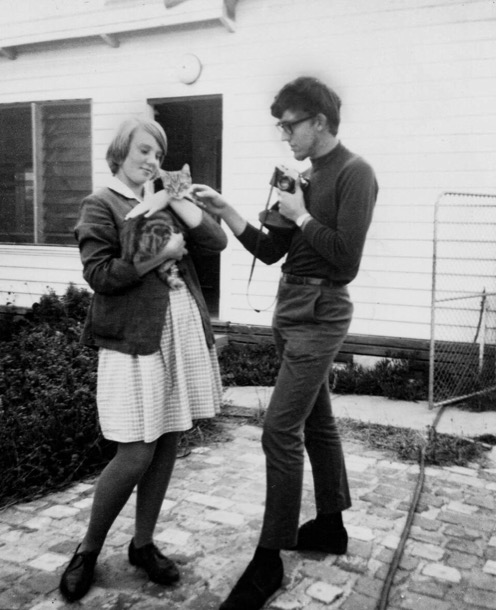
Margaret first met Fred, when he was in second year photography at RMIT and was running the Photography Club at Burwood High School, where Margaret was in Year 10. After Margaret played a part in one of the club’s movies and Fred went to the Year 10 Form Party, Margaret and Fred started ‘going out’. Fred then became an important part of our all of our lives for many years.
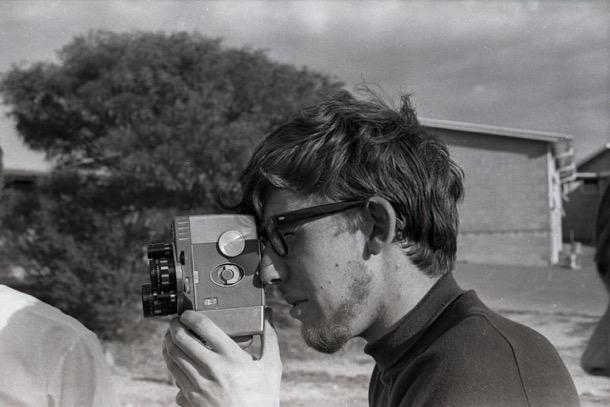
Fred, camera in hand was quite a usual pose in those days, as he recorded the minutia of our daily lives in Super 8 movie film.
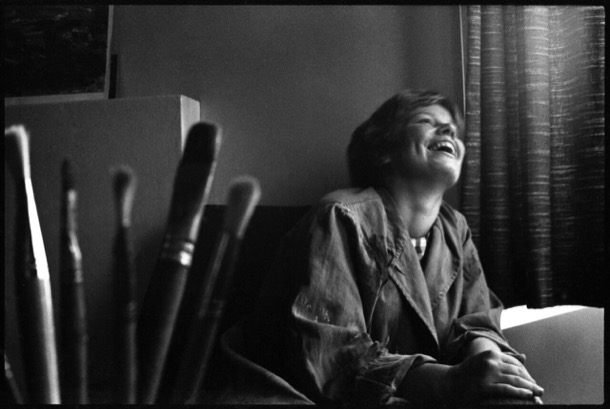
Fred also took many black and white stills with his Pentax SLR.This one is of me in first year of my Art course. I am wearing an old dust coat of Dads to paint in. Teachers in those days, particularly Science teachers, had grey dust coats to wear over their clothes as protection from both chemicals and chalk dust.
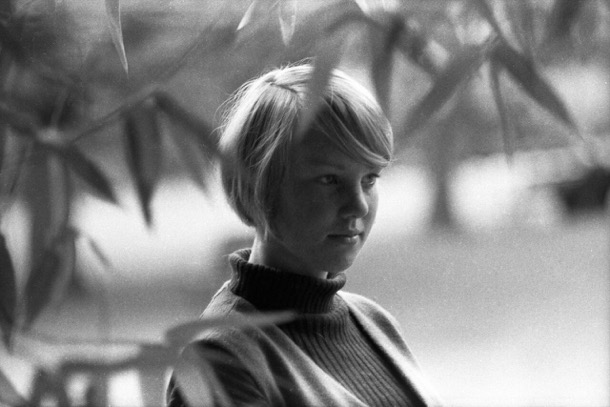
At the Botanical Gardens. Margaret about sixteen years old.
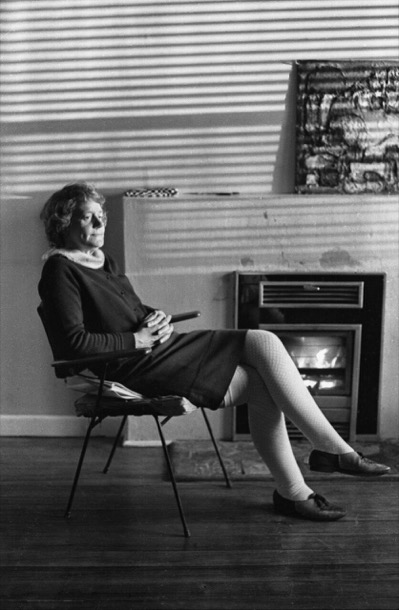
Our mother, Alice, in the lounge room at Moore Street, in about 1967. She was forty-four years old and had recently gone back to work for the first time since she was married in 1945.
When he sent these shots Fred commented, “I like it when you see your parents as young and attractive, virile. These two show a very frugal environment, with the only decoration someone’s school pencil case. If I was photographing her today, I’d automatically retouch that stocking top (and I can if you’d like) but it’s part of the reality of the time.”
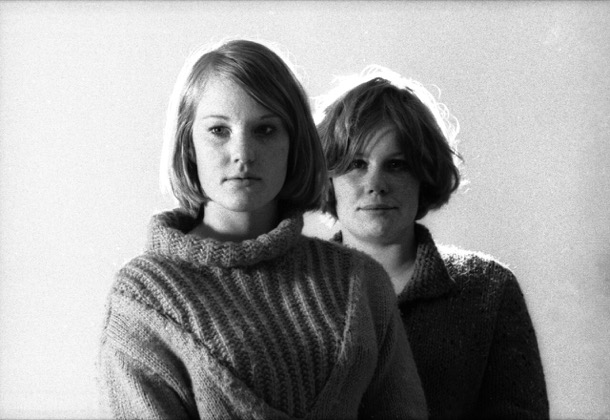
By 1968, Fred was working as a professional photographer. The Studio he shared with two other ex students from the RMIT course, was all set up with special lighting and backdrops. This shot of two sisters was taken there.
Decade by Decade
Here is the audio of this from the recordings:
With our more modern education, we have less of a firm grasp of History, and we know that our children, and their children have, and will have, an even sparser knowledge. So we have taken the overview concept, explained a little more fully, and added in our father’s family history and other aspects we have recently discovered.
Alice and Marge finished recounting their family stories at 1950. One of our tasks in this project has been to continue on from then, and so we have done just that. We explore the nineteen fifties, sixties and seventies, linking what was happening in the wider world into our own lives.
1850-1950
Between 1839 and 1872 our ancestors arrived in Australia.They came from both Northern and Southern Ireland, England, Germany and Denmark. All were from humble origins, having worked as agricultural labourers, domestic servants, a baker and an engineer. Some were already married and others met here.
As our ancestors built their new lives in Victoria, the First Australians had already felt the disastrous impact of European contact. There had been violent conflict, the Wurundjeri population had been decimated and the survivors relocated to reserves or camps a ‘suitable' distance away from the growing population of Melbourne and outlying settlements. In 1844, when the Bourkes took up their selection at Pakenham, they were the first white settlers in the area and the “blacks camp” by the river was noted in Catherine’s memoir. Several years later, Adam Rye, from the other side of the family, was robbed by a party of ’50 blacks’. The newspaper report notes that ‘the blacks at this time were very treacherous’.
With the discovery of gold, in New South Wales and Victoria, there was a huge increase in population and in wealth.
Victoria benefitted the most. Melbourne became Australia’s largest city, with a huge land boom. Grand old buildings like the Melbourne town hall and exhibition buildings are reminders of those glory days.
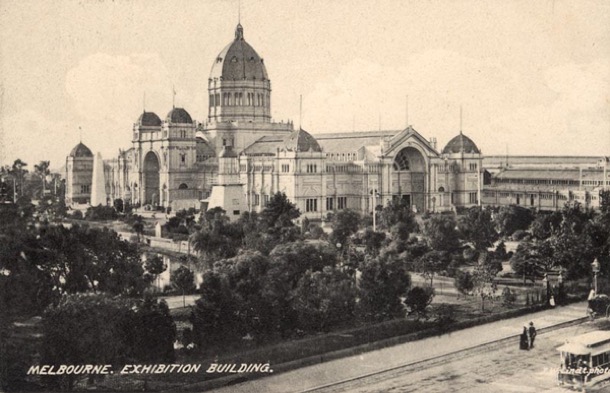
The increase in population, rapid development and the attraction of the goldfields led to a shortage of workers. This meant great job opportunities at every level. It also put workers in a good bargaining position.Trade Unions developed and working conditions were the best in the world. Australia was an egalitarian workers’ paradise.
Small businessmen, like publicans, bakers and lawyers, prospered with the growth in Melbourne. For farmers, it meant bigger markets, more mouths to feed. The growth in country towns, better roads and railway development made life in the country less difficult.
Engineers had a lot of work with the sudden development of infrastructure and property developers were run off their feet. Our grandfather’s grandfather, a young engineer from England, was building bridges in the expanding colony. While building the bridge across the Barwon River, his son, our grandfather’s father, was born, his birth unregistered.
Back in ‘Marvellous Melbourne’ our grandmother’s grandparents who had arrived from Belfast, were developing St Kilda: building large houses and public buildings for those who were prospering in the boom town.
On the land, our maternal ancestor Adam Rye, who had survived the attack by ’50 blacks’, settled in Geelong and worked as a farm labourer. He was later gripped by gold fever and went north to seek his fortune, only to be held up by bushrangers and lose his meagre pickings. His daughter married a German immigrant, Dau, and they settled on a mixed farm at Wandong. Here they raised seventeen children and supplied food to the growing population.
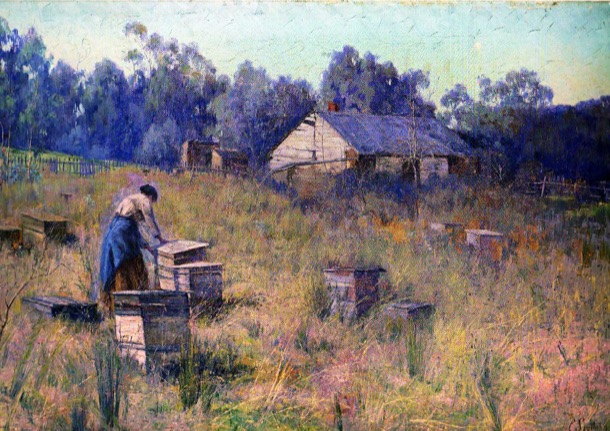
Meanwhile our paternal forbears, also on the land, were making their mark in Gippsland and North Central Victoria. In Pakenham the Irish Bourkes were building their family of thirteen children, and now owned Bourke’s Hotel. They were becoming significant landowners and community members, as they set about acquiring land, marrying their daughters well and establishing their sons on large and prosperous properties. They also served their community in local Government and built the horse racing industry in Pakenham.
1858 Land Sales, Michael Bourke's purchases:
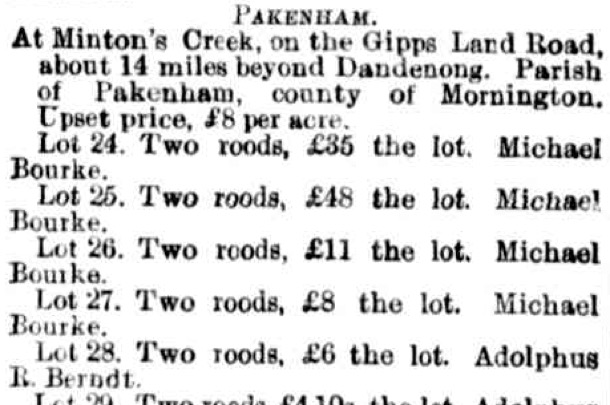
The MacCormacks, in North Central Victoria were also acquiring and working large grazing properties, firstly in Tallarook and then in Molesworth. They too were pillars of the local Catholic Church and community. Our grandmother was born there, at Balham Hill, pictured below.
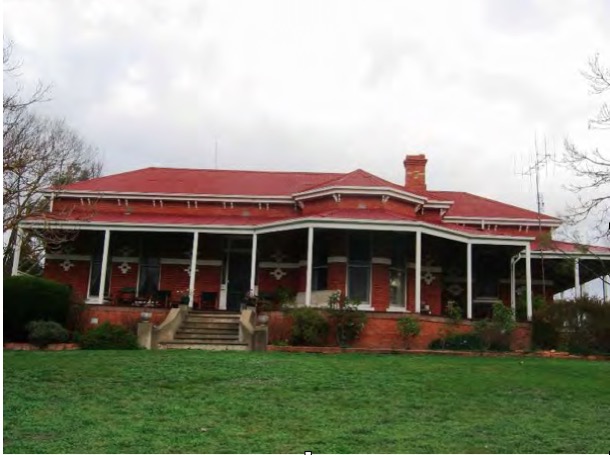
Melbourne became the financial centre of Australia and New Zealand. The Pakenham Bourkes’ fourth son, our great grandfather, was part of this world. He had moved to Parkville and built his law career in this thriving city. Australians were growing in confidence and the young nation was showing signs of an interest in its own identity. This was the era of Henry Lawson and Banjo Patterson, who wrote about the characters of ‘the bush’. At the same time, Tom Roberts and his paintings glorified the unique Australian landscape and the men and women who toiled there. This growing sense of identity and of nationhood is reflected in the moves for independence from Great Britain. During this era of optimism and hope our grandparents were small children, and their families were well established in both country Victoria and Melbourne.
Federation was achieved in 1901, and the country celebrated:
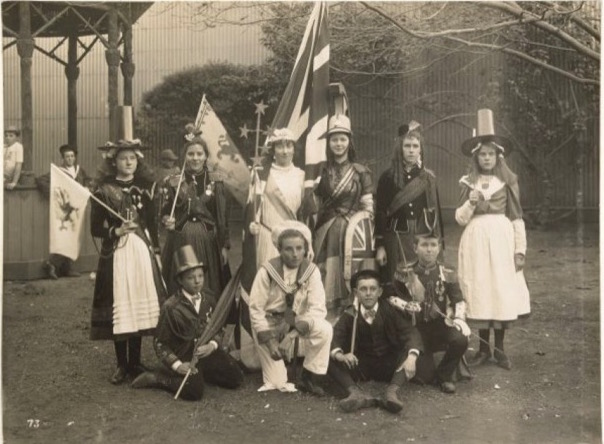
Australia was longer a colony but an independent nation. Melbourne was the largest city in Australia at the time and the second largest city in the Empire (after London). It was fitting that the new Parliament should sit in Melbourne while Canberra was being constructed.
The decade after Federation saw Australian women join the battle for women’s suffrage. White men over 18 in Victoria had had the right to vote since 1858, but women were not granted this right until 1908. Our maternal grandmother, Alfreda, was sixteen when women were granted the right to vote. We imagine she would have approved. She had been engaged in her own battle to pursue her dream of further education; and during this decade she finished her secondary education at Melbourne’s Continuation School, the opening of which marked the beginning of state secondary education in Victoria.
This period of prosperity, optimism, and political and social change ended in the devastation of the Word War 1. We know little of the family’s war service, but three of our maternal grandfather’s uncles served in France, and one lost his life. In the highly charged patriotic atmosphere of the time, and with mounting casualty lists, the war years must have been a difficult time, especially for our grandfather who was considered unfit for service due to ill health. He was deeply upset when given a white feather. Presumably our paternal grandfather being a country doctor, was in a protected occupation.
Our grandparents were all married at the end of this war. Our father’s parents were married in St Patricks Cathedral in a grand affair. Grace and Hugh then settled in Koroit in the Western District, where Hugh was the local doctor.
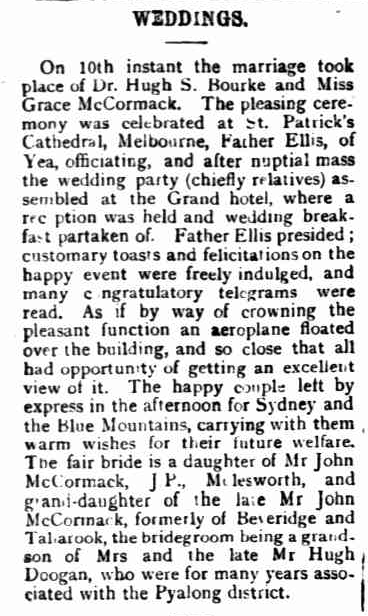
In contrast our mother’s parents were married in the Methodist Church in Surrey Hills in a small and simple ceremony where the bride did not even wear a wedding dress. At that time Alfreda was working as a teacher and Alf was working in a hardware shop in the city. They also moved to the country, soon after: to Eildon, where hardware supplies were needed for the construction of Eildon Weir.
Our family then lived through the Great Depression of the thirties, formative years for our parents who were by then at school. Our father was boarding at Xavier College and our mother was at Croydon Primary School. By the end of the decade the world was at war again.
During the war in a munitions factory, in Maribyrnong, two very different family histories were to merge into one. One was Irish Catholic, successful and quite wealthy, and the other was staunchly Protestant and relatively poor. One was involved in the Melbourne horse racing scene and the other was teetotal and interested in ideas and the new ‘isms’ that were emerging on the other side of the world. Our parents were married at the end of World War 2.
1950s
Our mother’s view of the 1950s, in her recording, is of a time of burgeoning economic growth and development. To us, it is the decade we first became aware of the world.
Our world was redolent with Australiana, but we were intensely aware of our British heritage, and it dominated our reading, our schooling, our whole culture. A portrait of The Queen hung in our school. Sue remembers keeping a scrap book at home of magazine articles about the Royal Family. She was particularly interested in the corgis. Apparently I had one too, and it contained very many pieces about Princess Margaret.
Enid Blyton Books:
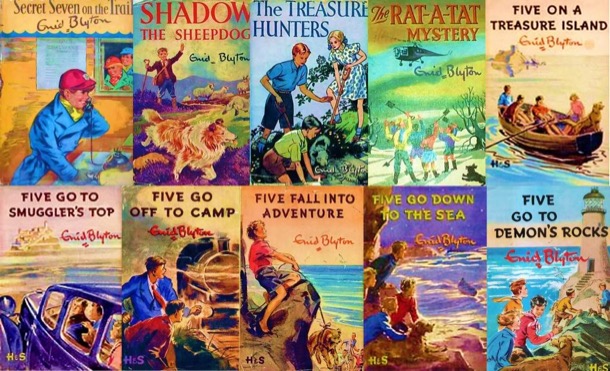
Globally, it was a dangerous world, with the cold war in full swing, and a very real threat of nuclear war. Our parents had quite well developed political opinions, particularly our mother, so we were exposed to adult conversations about the issues of the day. Family friends and neighbours, the Lees, were active in the union movement. They encouraged our parents’ involvement in the movement for “unilateral disarmament” and other left wing activities. I remember our mother’s admiration for an older couple who took a small boat out into the Pacific Ocean to protest the nuclear testing. Bikini Atoll in the Pacific, sixty years on, is still a no go zone from the USA nuclear tests carried out there up until 1958.
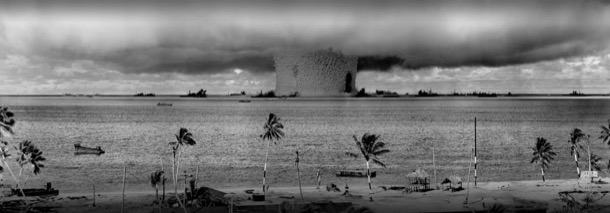
This was the time of McCarthyism in America, and Australian political attempts to ban the Australian Communist Party: a divisive time, where everyday people had strong opinions one way or the other. Sue remembers Prime Minister Menzies as “the devil incarnate”.
The Campaign for Nuclear Disarmament became overwhelmed in the 1960s by anti Vietnam War action, but it was an important political movement of the 1950s. The familiar “Ban the Bomb”, or “Peace” symbol was invented in 1958, as a symbolic representation of ND (Nuclear Disarmament)
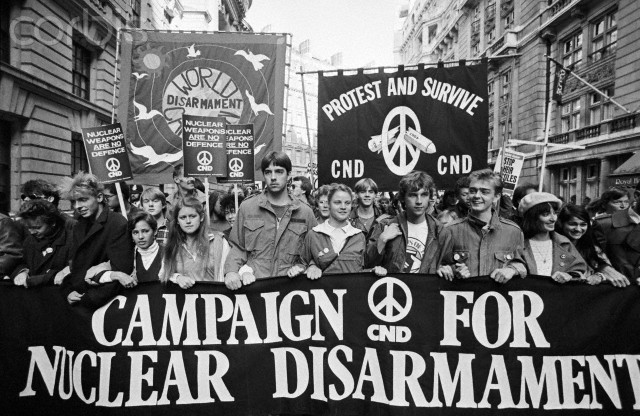
Our family was, by today’s standards, quite poor, but this did not impinge on our life, at this time. We were well fed, we had a stay at home mother who looked after us and the struggle to pay bills was not part of our conscious experience. As far as we children knew, we were neither poorer nor better off than our neighbours, with the exception of the family in the housing commission house nearby, whose son had polio and who didn’t always have enough to eat. The world, as we observed it in our daily life, was largely classless. Perhaps Australia at this time really was the egalitarian workers’ paradise it purported to be, to prospective migrants in Britain. (only whites of course)
Nevertheless, we knew about the religious and economic differences within our family: that our father’s relatives were wealthy and that we were not, because our parents’ union was a “mixed marriage” and very disapproved of. We were very aware of their Catholicism and our Protestantism, and that we were not as close to our grandmother as our cousins were.
Our father during the 1950s, went from working as an industrial chemist by day, and studying by night, to full time teaching. We got our first car, a television and a refrigerator. By the end of the decade there had been four children born. It was busy, but simple life, encumbered by very little “stuff”.
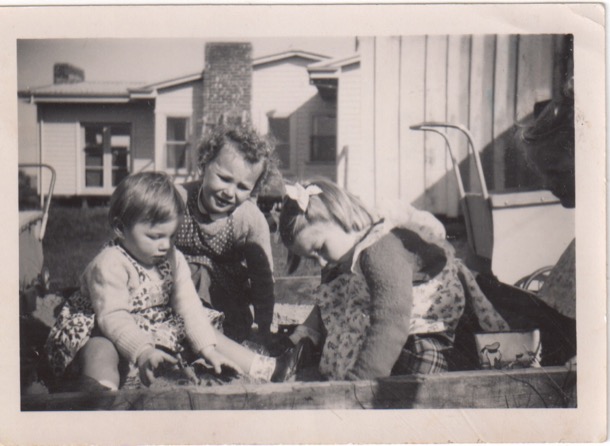
Our suburb of Box Hill South was the edge of suburbia, when our parents first bought their block. During the fifties the new suburbs filled in with more and more families, and the frontier stretched east towards the orchards of Blackburn.
Below is Doncaster, contrasting the 1945 view to that of today. It was little changed in the 1950s. We remember breaking an axle on our Talbot car in Doncaster, a farming and orchards area with narrow unmade roads.
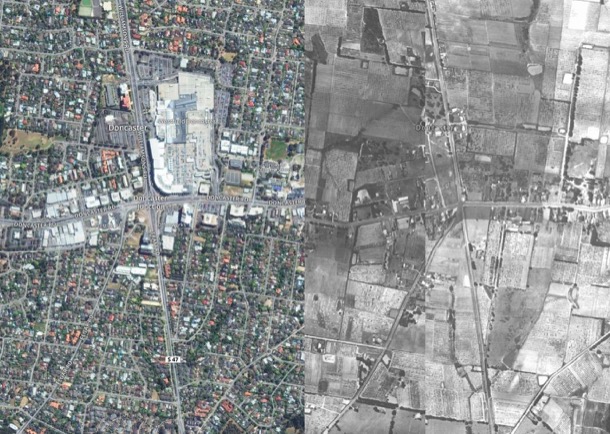
The sewerage reached us during the late fifties. Neighbours got together to dig each others’ trenches. The footpaths were paved, allowing us to roller-skate along them.
The streets were deemed to be safe enough for five year old girls to walk unsupervised, from Box Hill South to Surrey Hills to Sunday School and to Bennettswood to school.
We are baby boomers, and this was the most booming time. When we began school, Sue in 1954 and me in 1957, “temporary” schools were being thrown up, and unqualified teachers recruited to deal with the rush.
My first experience of school was a few weeks in “bubs”, and then the-bursting-at-the-seams class was reduced by a handful of us being put straight into Grade 1. Here is that grade photo with Miss Meadows and her 47 pupils.
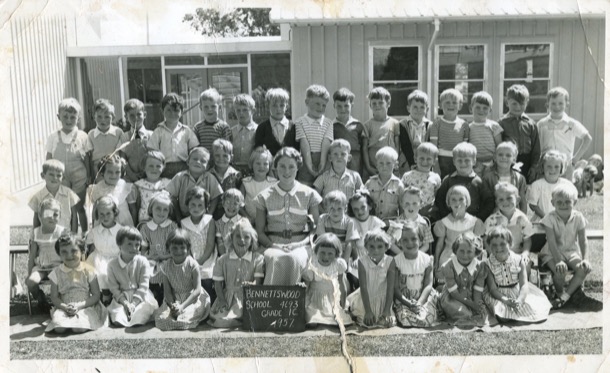
1960s
This decade covers our teenage years. It was a time of huge change in the western world. By the end of the decade, Neil Armstrong had walked on the moon, women were controlling their own fertility with the Pill and popular culture had discovered the huge Baby Boomer teens market. During the sixties, there was a general loosening and questioning of traditional social norms. Older people were probably more aware of these momentous changes. For us the loosening of the cultural apron strings, that is such a feature of these times, coincided with the loosening of our familial apron strings.
The conflict between our generation’s straining at the bit and society’s entrenched traditional values played out in our school life. As fashion hemlines rose, school uniform strictures fought them. We knelt to have the gap between our uniforms and the floor measured precisely, and hastily pulled down our hoiked up dresses whenever a teacher came in sight. The anti war slogans on our pencil cases, alongside the names of pop groups we fancied, had to be kept hidden, or there would be detention. A new rule dividing the grassed hill area into a boys’ side and a girls’ side transformed the hill into a vast empty space with a cramped central area where everybody sat alongside the invisible line. In our school, as far as we can remember, there were no brown faces, hardly any Asian faces and no Aborigines. Foreigners were the Italian and Greek “new Australians”, and even they were rare in our (then) outer Eastern suburb.
Culturally, as more and more families spent more and more time around the television set, American culture rather than English, began to dominate our life.
We can’t remember exactly when we got a television set, just that it was bought specifically for watching cricket. As a family we watched the Australian serial Bellbird, which preceded the seven o'clock news. There were a succession of American sit coms we all watched, like My Favourite Martian, Bewitched, Father Knows Best, the Donna Reed show, Bachelor Father, My Three Sons and Mr Ed. After school I remember Clutch Cargo, Sea Hunt, George Reeves in Superman, and Hogan’s Heroes, F troop and Bonanza. And very rarely we were granted permission to watch 77 Sunset Strip. These are nearly all American titles. There were Australian and English shows too, but it is the American ones we remember.
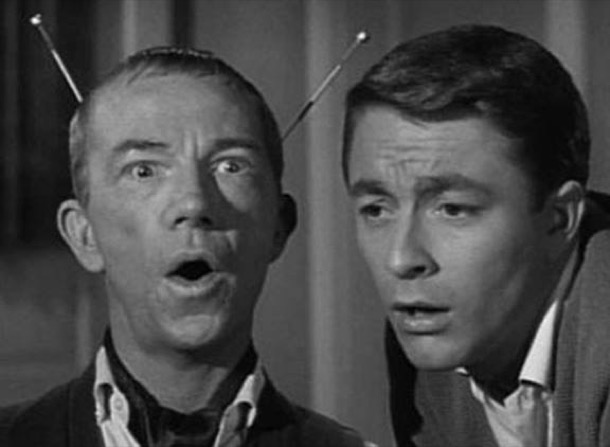
With this American influence in our lives, and increasing prosperity, “teenagers”, a term first heard in the 1950s, emerged even more as a marketing target. For the first time, teenagers had their own music, fashion, language. I was more plugged into Teen culture than Sue. I began to go to local Saturday night church dances from about aged 14. There was always a live band who played rock and roll covers. A group of us from church would go.
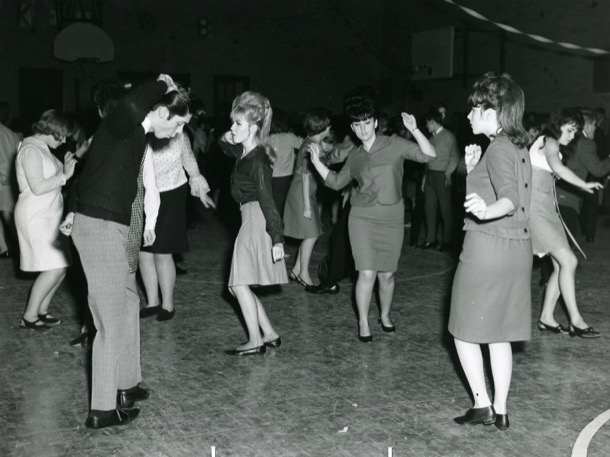
Dress was quite formal, ties for boys and stockings and heels for girls. I remember the winter that plain coloured wool dresses with white crocheted collars and cuffs were all the rage: probably 1965. Auntie Bert, dressmaker to the wealthy ladies of Melbourne, made me a tailored aqua one with little kick pleats around the bottom.
Below is fourteen year old Margaret in the aqua wooden dress with while crocheted collar and cuffs.
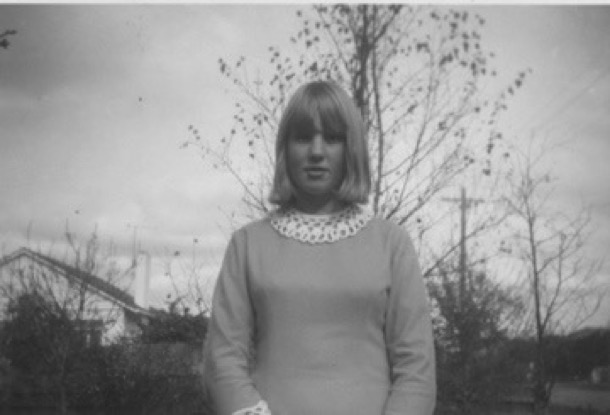
During the 1960s, Australians were entrenched in the divisive Vietnam war. Our family was by default anti war, and the “all the way with LBJ” policy of our government was fiercely criticised. In 1967, my boyfriend and another close family friend was conscripted for military service. Against huge opposition, the government had voted to call up into military service some twenty year old men. Many of them ended up fighting in the jungles of Vietnam. Our mother testified in court for the other friend, who was a registered conscientious objector. But many other friends and acquaintances went off to Vietnam with their hair shaved and very basic training. Some of those veterans live with the trauma of those experiences even today.
A "Save Our Sons" movement protested against conscription:
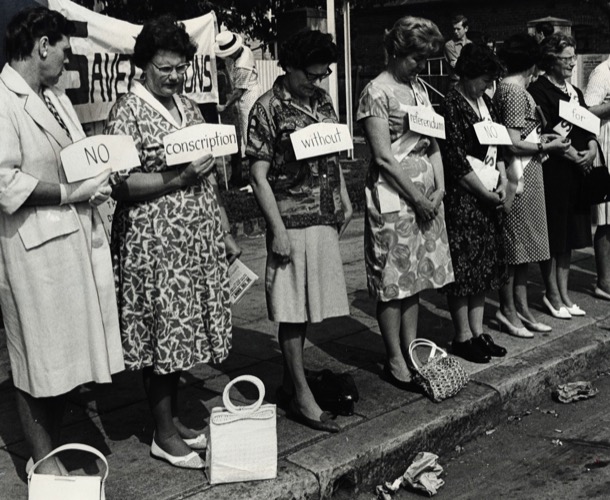
Gradually, public opinion in Australia, as in America, swung firmly against the war; and ordinary Australians demonstrated in the street.
By 1970, Sue and I had left school and were engaged in our tertiary studies, sharing a house in North Balwyn. University was still expensive, and we both managed it by gaining a bonded scholarship called a Studentship, which paid our fees, as well as a small living allowance. Even in a relatively enlightened family like ours, it was made clear that any family budget that was to be spent on university studies, was to be saved for our younger brothers, because they were boys.
1970s
The 1970s was a decade of change for us personally, and a tumultuous time worldwide. In some ways, the decade was a continuation of the 1960s. Women, gays and lesbians and other marginalised people continued their fight for equality, and many Australians joined the world wide protest against the ongoing war in Vietnam. Outrage at the continuing conflict was fuelled by the graphic coverage of the brutality of war, available nightly on our TV screens.
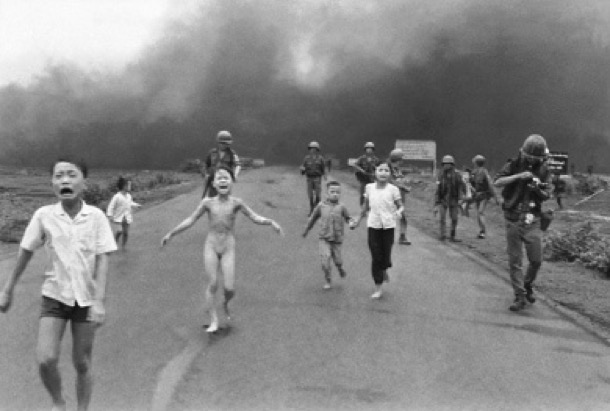
Protest was bitter and violent.
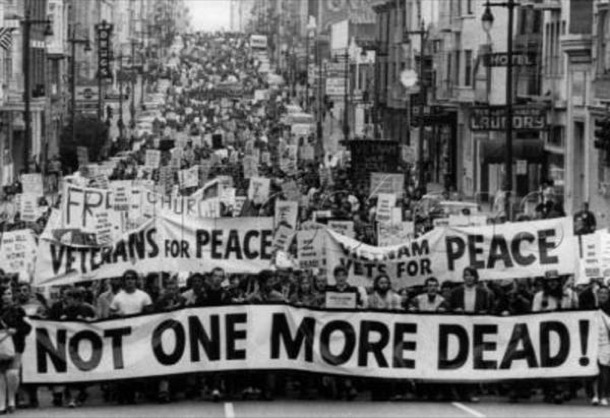
By 1975 Saigon had fallen: a humiliating defeat for the USA.
There was more violence as Pol Pot and the Khmer Rouge murdered 1.7 million Cambodians, and on the other side of the world, the IRA fought for British withdrawal from Northern Ireland.
Rapid advances in technology were in play, changing our world and planting the seeds for the creation of digital world, we are grappling with today. Apple launched the Apple 1, a desk top computer, pocket calculators were commercially available for the first time, and music became mobile with the release of the Sony Walkman.
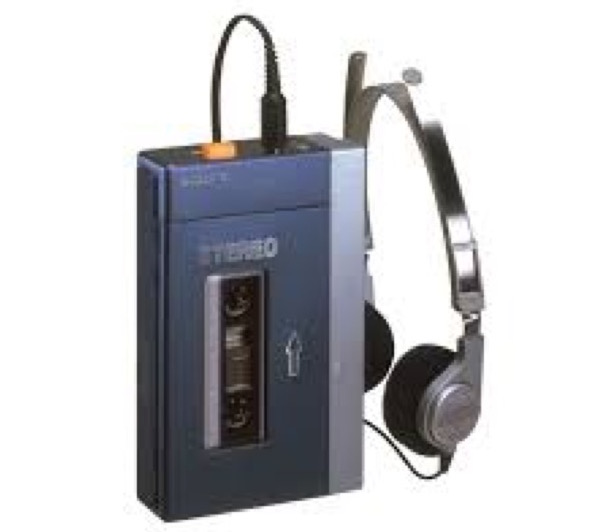
In the popular music scene, Elvis Presley died, the Beatles split up, the Sex Pistols band recorded an album and disco music took the world by storm.
In Australia, at the beginning of the decade, Gough Whitlam led the Labour Party to victory in the 1972 election. This ended twenty-three years of unbroken Liberal-Country Party Coalition government.
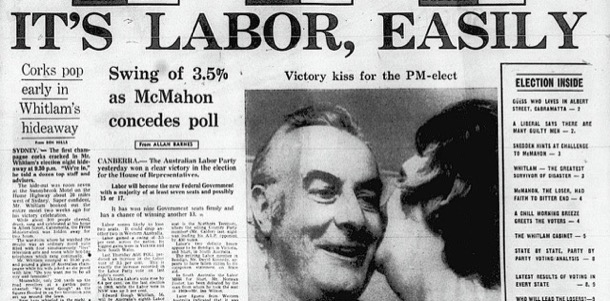
Change was inevitable and rapid: the troops were brought home from Vietnam; educational reforms were introduced, such as free University education; and Whitlam visited the feared red menace, Communist China. Inept financial management, scandal and the rate of change contributed to another landmark event now known as, The Dismissal. Whitlam was sacked by Kerr, then Governor General.
Gough Whitlam stood on the steps of Parliament House and declared “Well may we say ‘God save the Queen’, because nothing will save the Governor- General”:

The Liberals returned to power under Malcolm Fraser. For Labour supporters like us, it was a bitter pill.
Waiting in the wings was Bob Hawke, who was both President of the ACTU and President of the Labour Party. The 1970s ended with Hawke deciding to enter politics. He was elected as the member for Wills in the 1980 election and Labour was once again in power. The 1980s in Australia was Hawke’s and Paul Keating’s decade. The reforms they ushered in changed the face of Australia: we thought for the better.
At the beginning of this tumultuous decade Margaret and I were fancy free. We moved out of home, sharing a house and living on our teaching studentships, as university education was not yet free. Margaret supplemented her income, paid $1 an hour, working at the first fast food outlet in Bourke Street. Working the late shift posed no danger as the Derby closed about 11 pm [very late] and Margaret was able to walk out to her Morris Minor parked right outside the restaurant. “It was always easy to park in Bourke Street, there were lots of parking spots,” remembers Margaret. It was such a different city then. We also embarked on our teaching careers. I began my teaching career in Sale and Margaret at Moe.
We had wonderful camping holidays, often in the Snowy Mountains; we saw interesting alternative movies at the Walhalla picture theatre in Richmond; we went to Sydney on the train to see Hair and saw nudity on stage; so risque! We listened to the Beatles, The Seekers, Cat Stevens and Peter Paul and Mary amongst others, on vinyl of course.
Margaret had begun teaching at Moe in 1973 and Jono and I, after a year overseas, both taught at Drouin High School, quite nearby. By the end of the decade, I had given up teaching and was at home at Gowar Avenue with a three year old Anna. Margaret was teaching at Croydon and was living in Gully Crescent with Ken.
Conclusion.
Marge and Alice finished their oral family history with their weddings and the end of the Second World War. It was neat: 1850-1950. It left off when they were both about thirty, settled into the business of raising children.
We are finishing our own overview at the corresponding stage. For us, this is 1980.
In the very last minute of the recording Alice, by herself for this part of the process, reflects on the speed of technological change that she and Marge had witnessed in their lifetime.
“But there’s a sort of corresponding suddenness in those new technologies and we tremble, as we think you do too, at what the outcome of all this is going to be for your children.
So looking back over that hundred years, we see this period of rapid, strong and significant development: a development that began gently enough, but now, in 1990, is rushed and killing and devastating.
And we look forward into the future for you and for our grandchildren as a time where perhaps you will learn what de-development is all about, and maybe the graph is going to go gently and firmly and calmly for you, into a period that is not as frantic as the one we’ve lived in.”
Strikingly and shockingly, the suddenness and the devastation she speaks of in 1990 has not diminished, but increased. And now, in 2018, as we watch our own grandchildren navigating their way into the world, we too tremble at what the outcome of “all this” will be.
Meat and Three Vegs
Like many families, we were fairly poor as we were growing up. There were four children, only our father worked and "stuff" was very expensive. Food, however was relatively cheap, locally produced, fresh and plentiful by the time we Baby Boomers were on the scene. Our mother had been taught to cook by her mother, and the repertoire was pretty simple and limited in scope. Our mother was an ok cook. She knew not to boil the proverbial out of the cabbage, she used the limited available range of flavourings sensitively and she was open to the few new ideas that came her way.
As the fifties became the sixties, there was a fridge rather than an ice chest, the Womans' Weekly began to suggest new adventurous culinary ideas and there was a greater range of food in the shops.
In early 1964, when I was twelve and Sue was fifteen, our mother got sick. She had a condition called Thrombocytopenia, or low platelet count. Platelets allow blood to clot, so a person with not enough of them is in danger of haemorrhage. Eventually she had her spleen out and recovered. But for that year, she was tired all the time and generally felt terrible. Our youngest brother was only seven.
I remember a conversation early that year with a very serious Mum and Dad, just with me. The proposal they were putting to me was that I take on all the family cooking, to remove that burden from Mum.
I had been a kitchen assistant to her for a number of years. My memory of those years was that Sue cooked occasionally and always special, flamboyant things like interesting cakes, and that it was me who made the gravy and the custard, peeled the apples or rubbed the butter into the flour, often with my mother shutting the drawers in front of me, or wiping up my spills, complaining about how sloppy I was. (I still am!)
So, at age twelve, I became the family cook.
We hardly ever used actual recipes. Most meals were just cooked the way generations before had cooked. Even so, recipe swapping as a social activity was as prevalent then as it still is. Mum’s recipe book often had the name of the source: Joan’s biscuits, etc. Sometimes they were written on the back of an envelope or a scrap of paper and stuck in. There were also torn out recipes from magazines and newspapers. And there was also the PWMU cookbook.
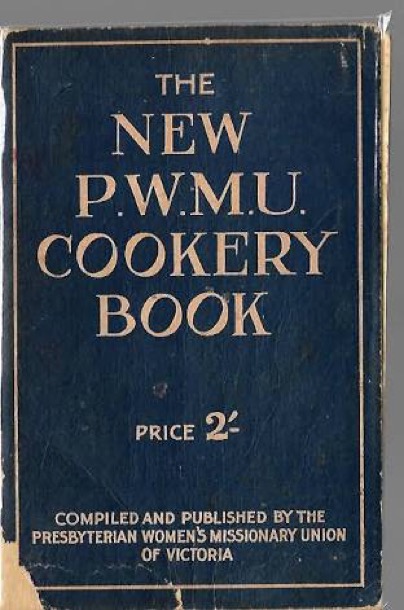
We were a family of six. We had an evening meal of meat and vegetables and dessert.
Three meals a day and morning tea were provided. Nothing was drunk with any of our meals, not even water. There would have been a cup of tea afterwards, but not at the table. After school and other hungry times we had unlimited access to bread and butter, and fruit. (almost exclusively apples and oranges). I remember mum saying, “fill up on bread”.
Evening meals
We always had meat, served mostly with potato, but sometimes white rice. Also on the plate were two or three other seasonal veggies. These included cauliflower with white sauce; lightly cooked shredded cabbage; diagonally cut string beans; fresh peas; boiled silver beet; carrots cut in rings; mashed pumpkin; brussel sprouts, cooked whole; carrot and parsnip together mashed with butter; marrow cut in rings, boiled and served with lots of butter, salt and pepper; leeks in white sauce; broad beans, included the pods. In the summer we often had a salad made from iceberg lettuce and tomato and some of: green capsicum, celery, peeled cucumber, and, later on, the very glamorous addition of chopped apple and orange. The salad was liberally dressed with home made salad dressing. This was made by beating up a tin of sweetened condensed milk with mustard, malt vinegar and salt. We also had pickled beetroot.

Here is a fairly comprehensive list of the “meat” part of the meal:
Roast leg of lamb, roasted with potato, pumpkin, parsnip and onion. This was served with a green vegetable cooked separately; gravy, made in the roasting pan from thickened meat juices; and freshly made mint sauce. Dad was always the one to carve, but not ceremoniously at the dinner table, rather, at the kitchen bench and the portions were doled out from there.
Roast beef, “corner cut”, roasted with the same vegetables.
The same roast meats, served as cold meat or fritters, with chutney.
Grilled loin chops, two each.
Corned beef, boiled. Warm with cabbage and potato, then as cold meat on subsequent nights.
Four quarter lamb chops, stewed with onion, carrot and peas. Served with mashed potato.
“Rice meat” - chopped veal, stewed with onion, stirred into plain white rice, peas, parsley and lots of pepper.
Smoked cod, boiled.
Steak, corner cut sliced about a centimetre thick, fried in the frypan, until it was grey inside and hard on the outside, served with worcestershire sauce.
Lamb shanks stewed with carrots and onions.
Gravy beef (stewing beef) stew. Served with mashed potato and other vegetables.
“Mr Wilkinson dinner” - boiled white rice, topped with minced steak cooked with mushroom soup, and shredded, lightly cooked cabbage. (This meal was introduced to us by the eponymous Mr Wilkinson while the two families were camping at Shoreham. On a two burner stove, it fed four adults and ten children.) (I still use this as a meal, although these days, I use a tin of lentils and fresh mushrooms.)
Spaghetti served with meat sauce (fried onion, tinned tomato and minced steak, thickened)
Ham steak and pineapple. (both fried in dripping)
Sausage meat rissoles, fried in dripping and served with mashed potato and “tomato sauce gravy”. The gravy was made by browning a big spoon of flour in the frying pan, then adding tomato sauce and water.
Pan fried fish. This was usually barracuda, bought at Vic market, served with chips bought from the Wattle Park fish and chip shop.
“Chow Mein”. This was made in the frypan: minced steak, dried chicken noodle soup, pineapple pieces, green pepper, shredded cabbage. Served with boiled white rice.
Meatballs made of minced steak flavoured with dried soup mix and cooked in a sauce made of tomato soup and chopped green pepper and tinned pineapple. Served with boiled white rice.
Lambs fry, (liver) fried with tomato sauce gravy, served with mashed potato
Camp pie (like spam) and tinned real ham - almost exclusively when we were camping.
Mum’s father, over the years when I was the family cook, lived alone in the flat the the back of our house. He also had to be catered for, and he had very specific tastes. He shared the dessert I had made, but for his main course, he insisted on his own menu. He would have on alternate nights, two grilled chops or stewed lamb shanks. And he didn’t even have the same vegetables as the rest of the family. He only had potato, carrots and beans. This meal was delivered to him before the rest of the family ate. I remember Mum wryly saying that he thought he was very easy to feed, because he had such simple tastes. Occasionally there was a complaint, delivered indirectly to me via Mum. Too much salt on the grilled chops, is one I remember.
Desserts
Dessert was a staple. We had it every single night. It nearly always had some fruit component and was served with home made ice cream (evaporated milk, sugar, vanilla, eggs), custard (made with custard powder and egg), sweet white sauce or “top of milk”, from the top of the unhomogenised milk, a bit like thin cream.
Apple sponge
Apple crumble
Baked whole apples, sometimes covered with pastry.
Jam roll
Bread and butter pudding
Steamed pudding - plain with jam in the bottom, served with custard, or butterscotch made with golden syrup, served with sweetened white sauce.
Tinned fruit
White rice with sugar sprinkled over it served with milk
Rice pudding
Jelly with fruit set into it
Golden syrup dumplings
Apple snow
Sago, cooked in a white sauce (looked like frogs’ eggs)
Junket, like a baked custard, with nutmeg sprinkled on the top.
Baked fruit, or sometimes tinned fruit, with a crunchy topping made with Weeties, sugar and dotted with butter
Banana custard
Television pudding. this was a self saucing chocolate pudding. It was Dad’s mother’s recipe, always called this, even though long before had a television.
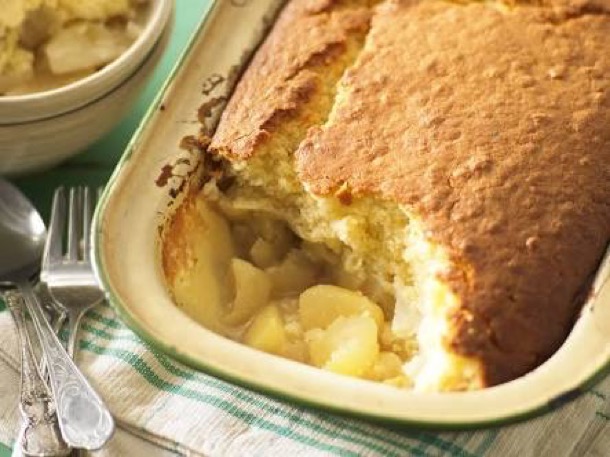
Apple Sponge
Breakfast
Weeties or Cornflakes with sugar and milk
Winter: porridge, with creamed oats (Creamota), sprinkled with brown sugar or golden syrup and milk.
Toast only on weekends or holidays
School lunches
Mum would get up early and stand at the bench in the corner and make lunches for the four kids and Dad, who was a teacher. She used the white bread that had been delivered the day before. She would slice the bread (at least fifteen slices). The butter was softened under the grill. We each had a round of savoury filling, cut into four little squares, and half a round of something else, often sweet. Fillings for the big one were always protein based, such as cold meat and chutney, cheese and chutney, egg and lettuce, baked beans, cheese and sliced green capsicum; and the smaller one was honey, jam, peanut butter and chopped dates, sultanas etc.
There was always homemade cake or a biscuit and either an apple or an orange. Cakes were boiled fruit cake, spice cake, queen cakes (like cup cakes), orange cake, and the biscuits we remember are anzacs, coconut biscuits and custard powder biscuits.
The food was wrapped in greaseproof paper and all put in a brown paper bag.
We didn’t take drinks to school. The school had drinking taps, and we always had a third of a pint of milk at morning play, provided by the government. In summer it was warmed and occasionally even curdled by the sun. We coveted, but didn’t have ourselves, “flavoured straws”, where one sucked the milk through straws coated on the inside with chocolate or strawberry flavouring.
Very, very occasionally there was a lunch order. I remember big mugs of tomato soup, and hot pies.
Weekend Lunches
Scrambled eggs on thick slabs of buttered toast
Poached eggs (two each) also on buttered toast
Fried eggs, cooked in the frypan, so they came out square
“Hamlet”. This was eggs and milk beaten up together and fried in butter in the frypan. It was served as thick pale slabs, served often with tomato and onion sauce.
“Spaghetti muck”. Fried bacon bits and onion into which was stirred eggs, cooked spaghetti and tomato sauce. (Ian’s favourite)
Baked beans on toast
Large boiled frankfurts, sometimes served with sauerkraut which we bought from the Box Hill delicatessen.
Tinned tuna in white sauce, served on toast.
Toasted cheese, slightly blackened blisters of processed cheese on big slabs of white toast.
Treats
Interestingly, desserts and homemade cakes and biscuits were not seen as treats, just part of our normal diet.
- Cocoa, made with whole milk with lots of sugar
- Broken biscuits from the delicatessen - sweet or savoury
- Pancakes with sugar and fresh lemon juice
- Mixed cakes bought from The Golden Rule (the milk bar at Wattle Park) These were very carefully cut into smaller pieces and meticulously shared out. They included vanilla slices, laminations, neenish tarts, small bakewell tarts, apple slices, jam tarts, lemon tarts
- Homemade toffee. (made with brown sugar, butter and sweetened condensed milk.)
- Lollies. This involved walking to the shop and choosing. Lollies were sold as “so many a penny, or halfpenny”. But there were also larger ones like choo choo bars, crunchy bars, poly waffles, cherry ripes, packets of fags, musk sticks, chocolate covered caramels, liquorice straps etc.
- Icy poles and ice creams. Water icy poles were common. Ice creams mostly meant a scoop in a wafer cone. There were three flavours: vanilla, chocolate and strawberry. (Incidentally I, Margaret, was promised six ice creams if I stopped biting my fingernails. I did, and I ate them all, one after the other!)
- Birthdays - the family dinner as per usual and then a home made sponge cake, filled with cream with white icing on top, candles and our personal flower. This was whatever was in season on our birthday. Sue’s (August) was hellebores, mine (September) was crab apple blossom.
- Take away dinner. Some time during our early childhood, a Box Hill Chinese restaurant began selling food as take away. Prior to that, at least in our world, there had only been Fish and Chip shops, (and we only ever got chips and potato cakes), bakery products like pies and sandwiches and a rare lunch time visit to Ball and Welsh cafeteria with Auntie Marge. So, occasionally, we would take two or three saucepans (no take away containers then) to the Chinese Restaurant and bring home exotic wonders like Chicken and Almonds, Sweet and Sour Battered Pork, Beef and Green Pepper and Special Fried Rice.
- When we were camping, there were other treats: cordial, made up from little bottles of concentrate and huge amounts of sugar; toast (we had sliced Home Pride bread there) with butter and vegemite or marmalade for breakfast. Drumstick ice creams as a reward for the long walk to the store. Then, on the long way home in the car, at the end of at least six weeks’ camping, there would be the bag of lollies bought with all the saved and hoarded pocket money. I remember the difficult decision - quality or quantity? I was disappointed the year I chose several packets of lifesavers, but, equally upset that a few special lollies disappeared far too soon.
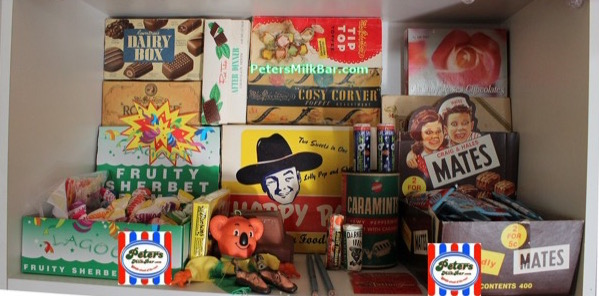
Table manners
We ate dinner either at the kitchen table or around the big blackwood table that had been our grandmother’s. There was a table cloth and cloth serviettes in serviette rings, and the table was properly set. Dad and the boys had to wear a shirt to the table, even if it was very hot.
At least for a while, Grace was said. ‘For what we are about to receive may the Lord make us truly grateful, Amen.” If Grace wasn’t said, then the signal to begin was when the last person sat down at the table.
We had to hold our knife and fork correctly and chew with our mouths shut. I remember being admonished, “Don’t enjoy your food so much, Margaret.”

When we were on holidays, these strictures were lifted. We remember having rowdy toast eating competitions, and Dad being so disgusted that he made us eat our toast the way he had had to at boarding school. This involved putting the butter and jam on the side of the plate and cutting and spreading bite sized pieces of toast. It slowed us down, but the bonus was that you could eat much more butter that way!
Weekend lunches were also very informal. Later, when we had television, some of us ate lunch in the lounge with the TV on. We remember World Championship Wrestling being one of these lunchtime offerings, with our young brothers wrestling on the floor in front of it. Although we went to church every Sunday, lunch was still very informal.
Rubbish
We had one smallish galvanised iron rubbish bin, emptied weekly. There were never any left overs, but food scraps, such as peelings and well sucked bones were wrapped in newspaper and placed directly into the bin. There was very little packaging in those days.

Here is a drawing of the kitchen all this took place in:
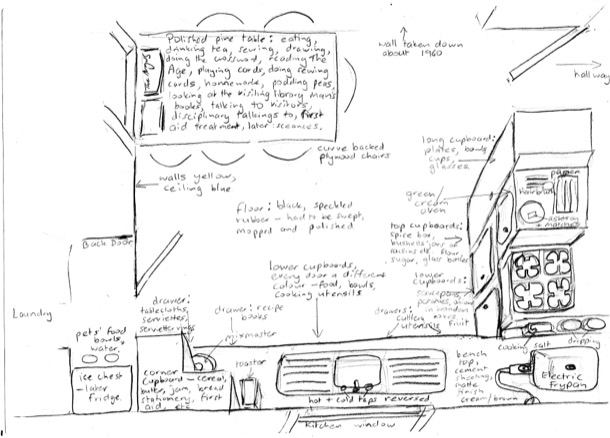
Shopping
All of this food cooked for this family of six plus one needed to be bought of course. Weekly shopping was the norm, as we only had a small fridge. The freezer compartment was only big enough for two trays of homemade ice-cream and ice blocks. A weekly shop for meat, fruit vegetables and a few groceries was all done without a car. This was the era of the local shopping strip with its butcher, greengrocer, grocer, newsagent and chemist. The Wattle Park shops were a little bigger, maybe because they were at a tram terminus. We also had two chemists a bank, a Mensland, that also sold our school uniforms, a wool and haberdashery shop, a barber, hairdresser, two milk-bars, and a cake shop. There was also a mysterious large shop crammed to the ceiling with all sorts of fabric, cottons and general clothing. Mr. Kline, a round bald headed man with a strong European accent owned and served in the shop . He was the only out of the ordinary person in this very suburban, white, Anglo Saxon world.
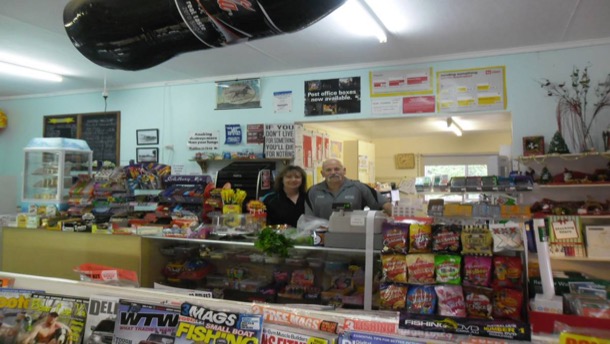
Mum walked down to the shops, probably on Fridays, shopping list in hand, and with children if they were still at home and not yet at school. Groceries, green groceries and the meat of course from the butchers were all left at the small supermarket for Dad to collect in the car after school. We cannot remember how the shopping got home in the very early days before the supermarket was built and when Dad rode his bike to work.
What would have been on the Shopping List:
NOT Bread and Milk as it was delivered daily
Tea [leaves of course]
White Sugar
White Flour - Plain and Self Raising
Cornflour
Custard powder
Icing Sugar
Vanilla
Cocoa
Coconut
Sultanas/Raisins/Currants
Dates
Jam in Tins [Plum, Raspberry, Marmalade}
Golden Syrup
Vegemite
Saxa Table Salt
Baking Powder
Bi Carb
Cinnamon
Nutmeg
Mixed Spice
Pepper
Tomato Sauce /Worcestershire Sauce
Keens Mustard Powder
Sweetened Condensed Milk
Tinned fruit
Tinned pineapple
Tomato soup
Baked beans
Tinned tomatoes
Tinned tuna
Chicken Noodle Soup
Powdered Mushroom Soup
White rice
Spaghetti
Malt vinegar
Butter
Kraft Cheese
Uneeda or Thin Captain Biscuits
Weeties / Cornflakes
Creamota Porridge
Rolled Oats
Rinso
Pine-o-clean
White Lily Paste
Jex
Velvet Soap
Toothpaste
Mum Deodorant [a white shiny paste]
Kiwi Shoe Polish
Dog and cat food
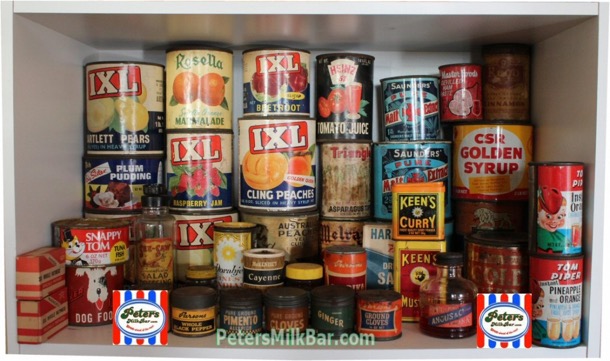
Everything we bought and ate was made in Australia.
Green Groceries consisted of the basics and was governed by seasonal availability. For instance we did not have tomatoes or bananas all year round and never had cauliflower in summer. Many of the fruits and vegetables that feature in our shopping today were unheard of, eg. eggplant, zucchini, avocado, asparagus, snow peas, all the asian greens, sweet potatoes, different varieties of potatoes, Spanish onions, fresh chilli, garlic or red and yellow peppers. As there was less variety, the shop was much smaller. Another difference was that you were served and did not touch the produce. No fruit or vegetables were wrapped or packaged. Your shopping was put into brown paper bags, wrapped in newspaper or just put into a box.
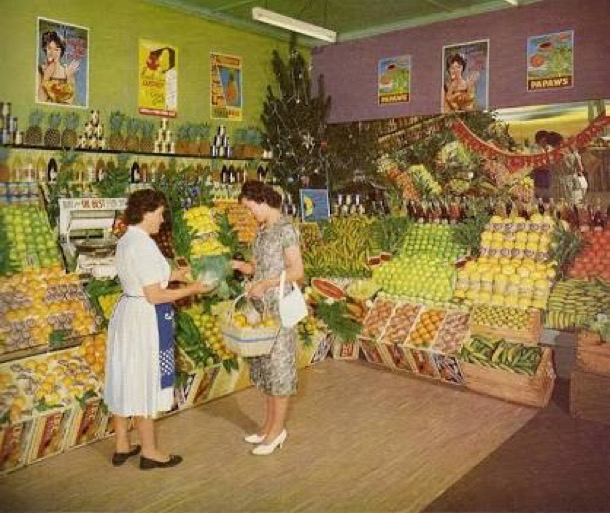
Meat was also very basic and varied little week to week. Once again the variety was not there, the bulk of the offerings being beef and lamb. The order would have been mince, lamb chops, gravy beef, a roast [that did 3 meals] and maybe lambs fry, sausage meat, shanks or smoked cod. Once again you were served and the goods were wrapped in shiny white paper and then newspaper.
Before the Supermarket opened in the mid fifties, other items were bought at the grocer. In the mid fifties the Foodland Supermarket opened introducing self service and the phenomenon of the checkout. There was now more processed food available, and we bought such items as Weetbix, dry and sweet biscuits in packets, baked beans, tinned fruit, Camp Pie and Kraft cheese. As the entire Foodland Supermarket consisted of two narrow shop length aisles the array was not vast and we only purchased enough to fit into three or four big stand up brown paper bags.
For a number of years when we were a little older, the weekly shop was done on Saturday morning at the Victoria Market. This was fruit and veg, meat from the big meat hall with the carcasses hanging from hooks on rails and fish from the fish hall.
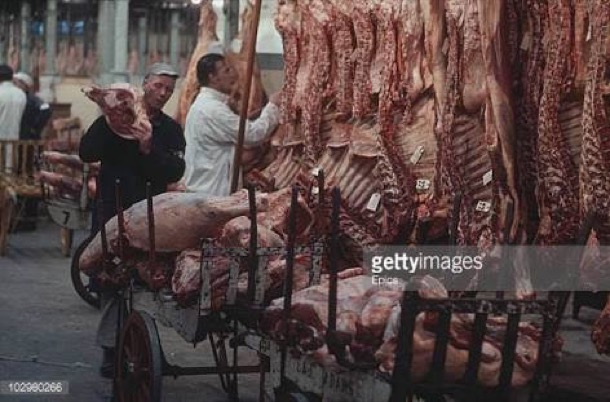
Besides going home with an abundance of food, obviously very cheap, the attraction was doughnuts and, believe it or not, the doughnut vans are still exactly the same, as is the smell freshly cooked doughnuts wafting in the air. The other special treat was a sweets stall: not the usual run of the mill lollies but big yummy humbugs and aniseed blocks and soft fat delicious liquorice. Best of all were the honeycomb blocks covered in thick good chocolate. Umm I can still taste it. It looked homemade and it all went home in crunchy brown paper bags.
The Victoria Market was an exotic and interesting diversion from weekly local shopping, but for most of our childhood, the weekly shop was done at the Wattle Park shops.
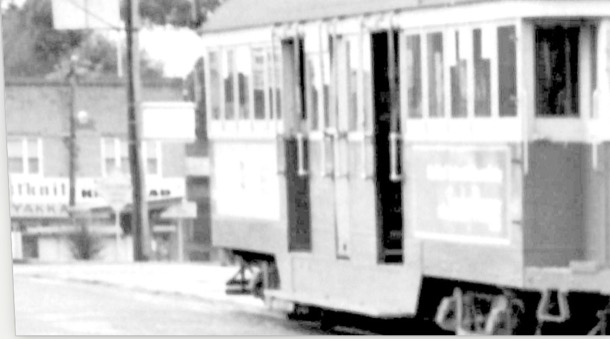
Wattle park shops from the tram terminus.
It must be remembered that shops were open on week days nine to five, and until midday on Saturday. After that everything shut down. Bread was in another category altogether, as no bread was baked on the weekends, not even Saturday.
An exciting diversion in our childhood, for maybe a year or so, was the advent of illegal bread baked on Sunday. Rebel bakers, defying the law, baked bread on Sunday and made it available to the public. In the days when few homes had phones, let alone mobiles and the Internet, word spread the old fashioned way: gossip. This initiative proved very popular, so much so that the trip to buy the bread needed to be made early in the morning or supplies ran out. We made the ‘long’ trip out to Blackburn, after Church to purchase our illegal bread. A few prosecutions were made for illegal baking and trading but the number of bakers increased, to fill the demand. Finally, the Government of the day gave in and repealed Section 105 of the Labour and Industry Act.
The Age in November 1958 reported on the heated discussions in Parliament, as rows over whether to allow bread to be baked legally intensified.
THE AGE, WEDNESDAY, NOVEMBER 19, 1958 18 Unhygienic Bread Feared. …Drivers. Labor claimed In the Legislative Assembly last night that the lifting of restrictions on one-man bakers would create an unhygienic state in the bread industry. They were strongly opposed to the Government's repeal of Section 105 of the Labor and Industry Act.
Today there is such an assortment of food and ingredients available for purchase everyday that it is strange to think of a world where a zucchini was an exotic vegetable, consumption of cheese was not an art form and chicken was from the old worn out layer from the chook pen, not bought from a shop. Coffee was Nescafe Instant and only the Italians in Carlton knew what an Espresso or a Cappuccino was. Today words like macrobiotic, whole grain, organic, grass fed and bio dynamic are used as slogans to persuade us to buy. We had very basic food made from fresh ingredients, the cheese may have been Kraft “soap” cheese and the bread white, but the meat was grass fed and the fruit and vegetables fresh and plentiful.
"Are you up to it?"
So now, sixty years later, we contemplated walking it again, those same roads and lanes, across that same creek. In our memories it was a long long way. “Are you up to it?”, Margaret texted Sue.
We park outside our old house in Moore Street and set off. And as we walk we remember:
Less than a minute into the walk, we round the corner into Grandview Road. To the west are the Dandenongs. The street trees are large and bright in their early Spring colours. It’s suburban, but well heeled and attractively quiet. We remark on a number of houses that seem unchanged. There’s the house where I babysat once, there’s another one where people from the church lived.
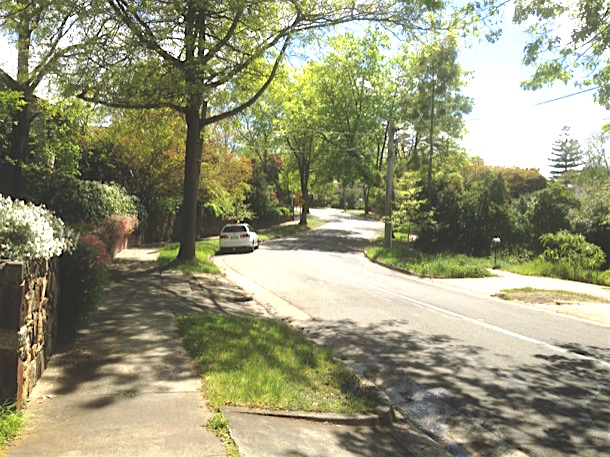
As we did this walk every school day, rain, hail or shine, we developed little rituals and markers, that now sixty years later we remember clearly. We often began our journey down Grandview Road, kicking a stone that we attempted to keep all the way to school. We don't think we ever succeeded.
Bright pink pig face flowers in spring marked the bottom of the hill. If the sun was out we always stopped and stared into the flowers for long enough for the world to turn green when we looked away. of course they are no longer there, but the rockery is.

“That’s the street to the Church just there! It’s so tiny! Everything is so close”
We have reached the bottom of Grandview Road in seemingly record time now the distances seem so small.
“I always liked this bit.”
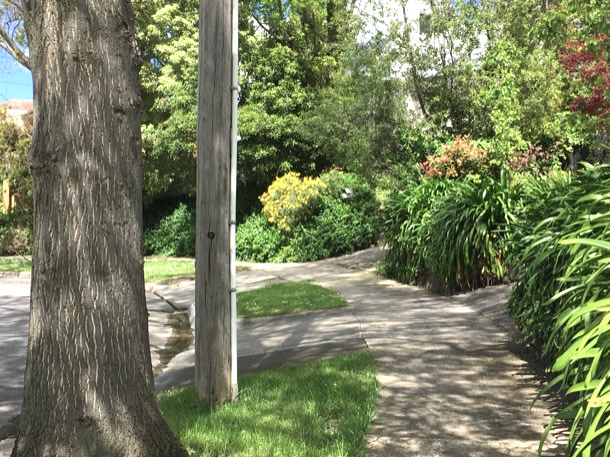
Heading towards Riversdale Road, still in Grandview Road we relive our childhood pleasure in beautiful gardens and leafy streets.
Riversdale Road is quite a major road, but still not too busy. Across from the end of Grandview Road is the entrance to “the lane”.
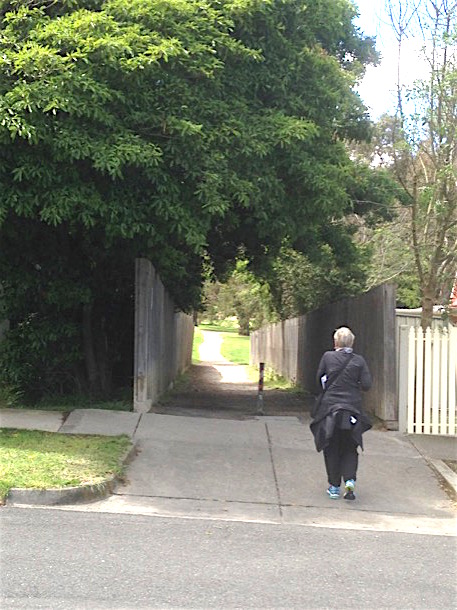
It runs alongside the house that our church minister and family friend lived in. Behind their house were the church tennis courts. That whole property is now a collection of ugly units.The lane continues a long way down the hill toward the creek. At every cross road is an opportunity to go a different way through the grid of streets.
We walk along Neville Street and remark on the difference in this much lower socio economic area. Many of the old public housing houses are still there, unchanged from the nineteen fifties’ building boom. They are noticeable different in style from the “private “ housing and, as children, we knew that they were “housing commission” houses and that they were for poor people.
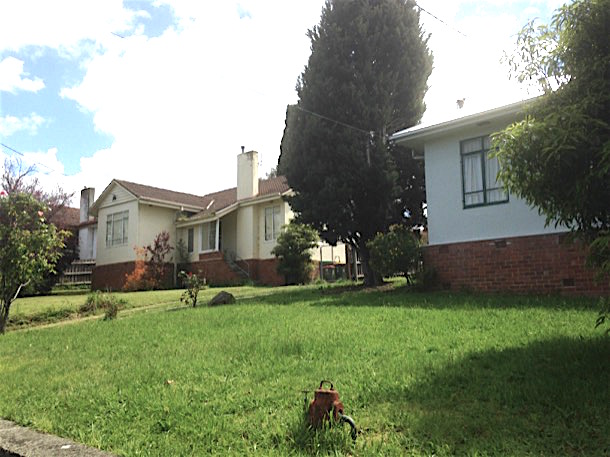
At the bottom of Stott Street we turn into yet another lane and at the other end we emerge into a green oasis.

Dogs are running free, chasing balls and each other, rolling in muddy puddles. Their young owners stand and chat. Up the hill a bit is a natural wood playground: slides, climbing frames, tasteful little forts. Further down the hill is a fenced off area of native bushland and, running through that the Gardiner's Creek. Well tended paths run along both sides of the creek and up to the adjoining streets. A noticeboard has a bird list and information about plans for improvement of the area. It is a pleasant Spring afternoon and Deakin students are strolling or jogging.
We conjure memories of how it was. This, the floodplain of Gardiner's Greek was the ‘wild’ section of the journey. The raised path, built by the fathers of the children who used this track daily, snaked its way across the grassed floodplain towards the bridge, also built by the fathers.

One old River Red-gum marked one of the bends in the path and large clumps of blackberries hid the creek from view. It was not the cherished indigenous community park it is now, but was a neglected wasteland. However it was interesting and often beautiful, especially in the morning. Sometimes we emerged from the lane to a white icy world, where spider webs hung between frosty grass stalks, glistening in the early morning sun. Sometimes the creek flooded. This was very exciting. We walked on the raised pathway, floodwaters on either side, wondering if the bridge was flooded. The water never covered the high bridge but the muddy torrent came very close.

On up the small hill past paling fences that belonged to cream brick houses we emerged on the school oval, the classrooms in the distance. Nowadays it is a multi story carpark.
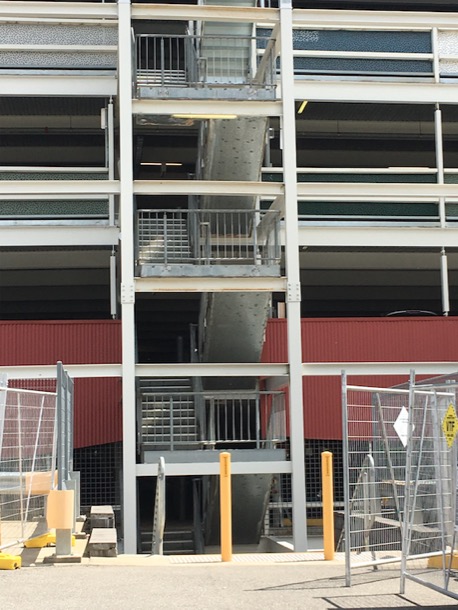
Our little school has been completely swallowed by Deakin University, along with the Teachers College and our secondary school, Burwood High School. We walk onto campus, and there, in the middle of the glamorous uni buildings is a little row of ex classrooms. There on the end is where my Grade four room was, here's the breezeway. Up on the edge is the quadrangle where we practised marching. There was a breezeway along there and Mr Stafford's classroom.

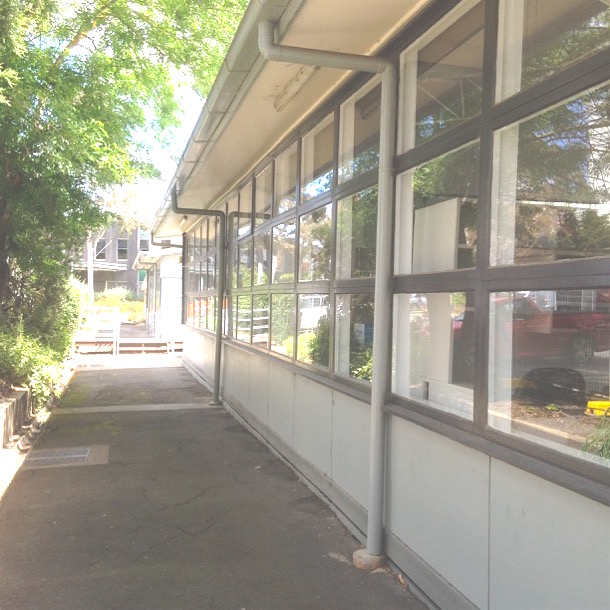
We set off past the car park again, cross the creek and head back into the criss cross of familiar streets.
At the corner of Cadorna and Inverloch Streets we work out the place where “the accident” happened.
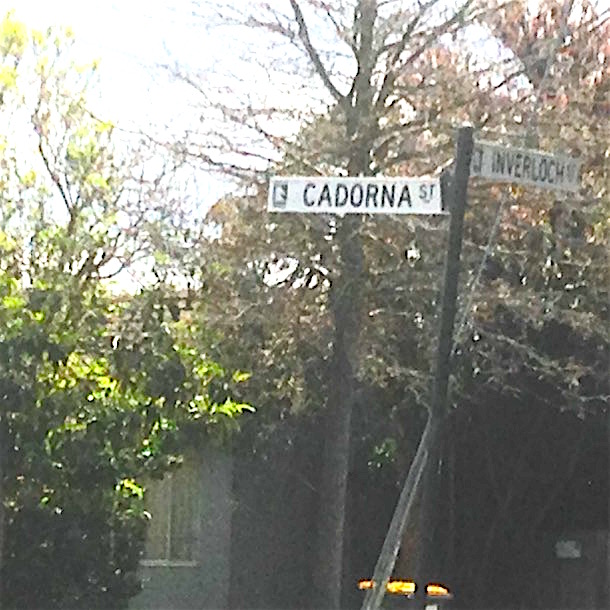
We remember it very differently of course: one of us watched in horror, the other was a participant. Here are our separate memories of it:
Sue:
Summer was a hot and dusty trek back across the creek after a full day at school. Once we had left the creek and started the climb up the hill in the hot suburban streets it was a bit of a slog. One such hot summer afternoon Margaret I were walking home with lan who was in Prep and the usual tribe of kids spread out across the two sides of the road. Margaret, seeing a friend on the other side of the road ran onto the road, straight into the path of an oncoming car. I don't remember much of the accident itself but I do remember a crowd of children and helpful women surrounding us as Margaret lay on the nature strip bloodied and battered with her head on my lap. The distraught young driver of the ute drove to get Mum (no mobiles) while we waited for the ambulance. Margaret disappeared with Mum into the back of an ambulance and Ian and I walked home.
Margaret:
I was nine, in Grade four. We were on the long walk home up the hill. Ian and Sue were there and lots of other kids. I ran across the road without looking, and was hit by a ute driving along Cadorna Street. It was a Friday.
After the accident I lay on the nature strip. “Ladies” from nearby houses tried to cover me with blankets, which I found irritating and pushed away. I remember Mum arriving and the ambulance. From my vantage point in the ambulance I remember seeing the corner of Riverside and Station Streets, as Mum told them they should be turning left not right.
At the Box Hill Hospital, I remember the decision of the doctor to pull out the tooth that was hanging loose. Two other teeth had been knocked right out, both of which had had gold fillings painfully inserted over the previous year, after an accident at gym.
At some stage there was a police interview. I remember Mum describing this process to someone else and laughing about the look on the Policeman’s face as he gently tried to coax information from me only to be presented with a dramatic and colourful description in far more detail than the poor man needed.
I remember coming home later that night. And then, possibly over the weekend, before I went back to school, I got mumps.
People bought presents: colouring books, a white china horse.
I guess the severity of the accident was exaggerated by the fact that I was laid up for weeks with mumps.
The sustained ongoing result of the accident was the absence of my three front teeth. Nowadays there would be counselling, PTSD and expensive restorative dental work.
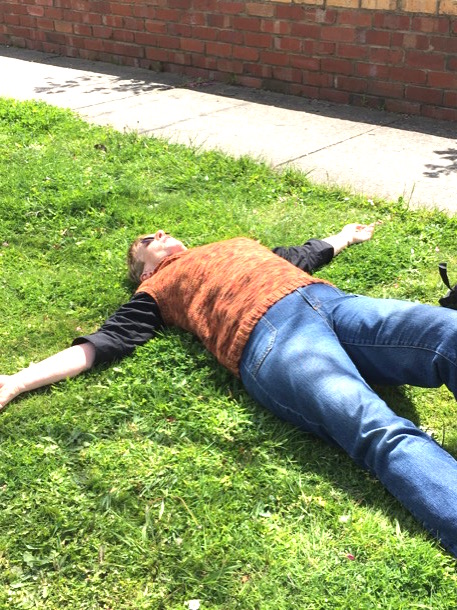
After the accident reenactment we begin to walk up lnverloch Street. It is long, steep and dull. There are no leafy street trees and interesting gardens. It feels like a concrete jungle. We reminisce about hot afternoons trudging up here lugging our school cases. We turn right at the first cross street, relieved to be able to use the lane instead.
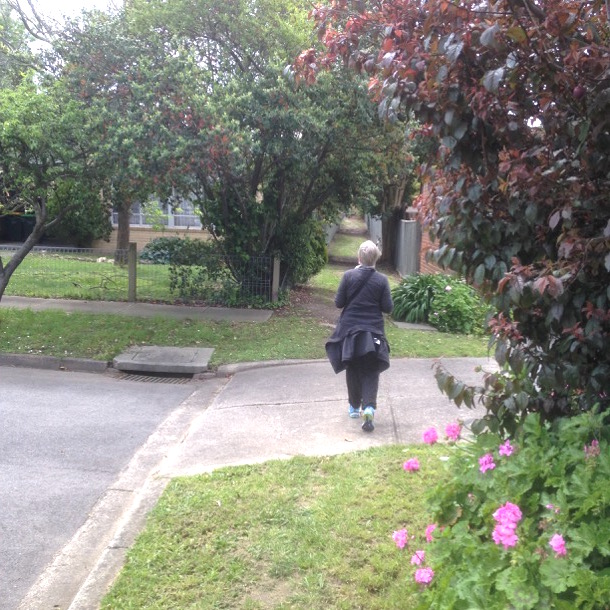
The lane takes us to the same place, the corner of Riversdale and Grandview roads, but it is much less steep. Soon we are crossing Riversdale Road and we remember the leafy cool shade of this part of the journey. It has seemed like a long way and we find ourselves trudging a bit up the hill.
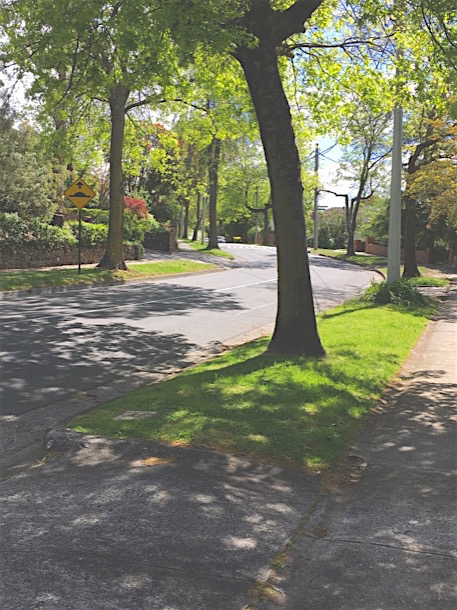
The homeward journey has taken about an hour, including the accident reenactment, stopping to gaze at houses we remember and a conversation with a lady in Neville Street who was interested to know what we strangers were doing in her street, where she knew all her neighbours, “except the Chinese who keep to themselves”. It’s a pretty fair representation of what our trip home would have been like. School finished at 3.30. So we would have been turning into the Moore Street driveway about 4.30.

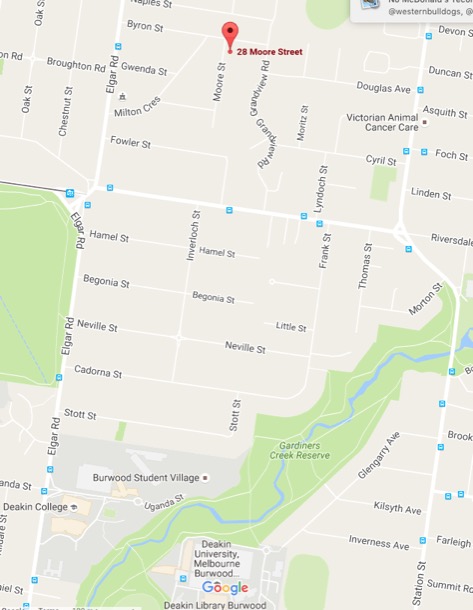
Twenty-Eight Moore Street
Alice describes the acquisition of the land in Box Hill South in 1946:
Dad built the house over the following six years, while studying night school and working full time at the gasworks in Box Hill. Sue remembers going to the Moore Street site, Dad walking and she riding her trike. On one memorable occasion, on the corner of Broughton Road and Elgar Road she remembers waiting while a circus went past: wild animals in cages and horse drawn vehicles.
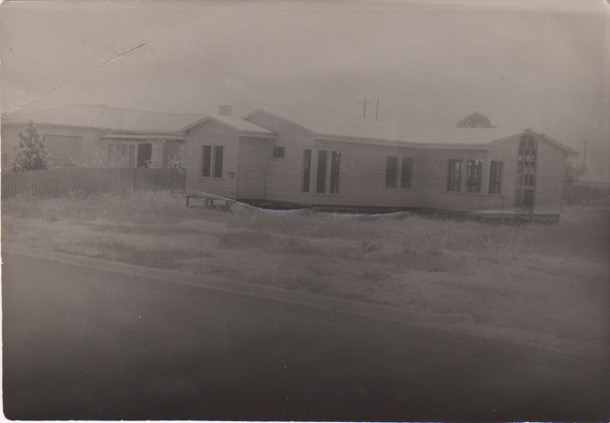
Neither Sue nor I remember the move from Boronia St, but it must have been in 1952. The house was never actually finished. The back door remained the one Dad had knocked up to lock up the house. We four kids all lived there until we were in our late teens or early twenties and our mother remained living in in the Moore St house until she was in her fifties.
The house is still there. It had a view over Mt Dandenong, and was pretty much on the edge of suburban development. Beyond, further east were orchards, unmade roads and “the country”.

Outside was a garden, overlooked by a grass terrace, which had French windows opening onto it. Later this terrace area became a “rumpus room” when our grandparents built a flat onto the back of the house in about 1960.
Right down the back was a vegetable garden and chook pen. Sue remembers hanging on the fence eating an apple, and looking into the paddock next door.
The driveway led through full height double wooden doors into the garage. I remember the garage full of shelves of smelly, dark looking tools, piles of sawn timber and car bits. Our first car was a Talbot, huge and square. it was cream with red leather
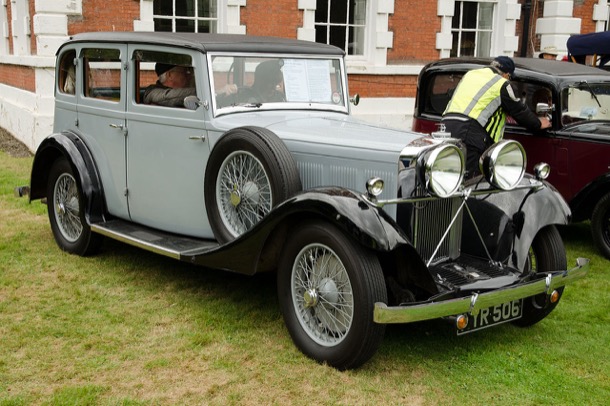
Later it was replaced with a Sunbeam. I remember being confused about the Sunday School song “Jesus wants me for a sunbeam”, but lots about life made little sense. This was just one other enigma.
Attached to the side of the garage was a garden tap, and at the end, a swing.
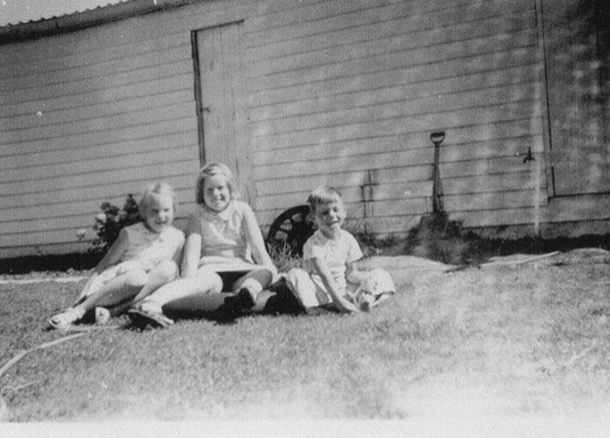
Part of the garage building was the alcove for the outside toilet, which we used until the sewerage came through. The toilet consisted of a can with a shelf above it, with the seat built into the shelf. At night we used the potty instead. Our bedtime instructions were “potty, teeth and bed”. The "can" was collected every week by the "dunny man".
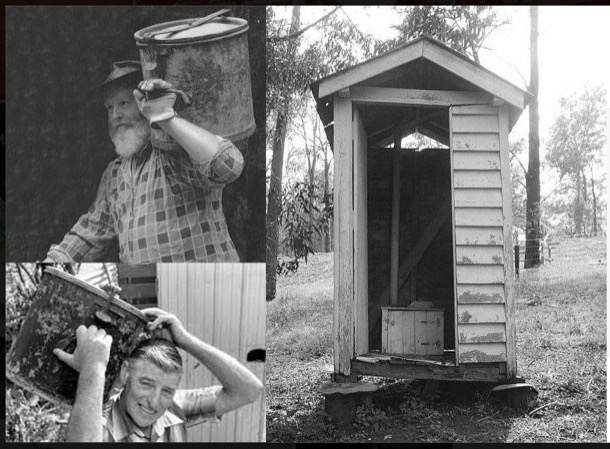
Moore Street House Room by Room
The Girls’ Bedroom.
Sue and I shared the front room of the house. Initially, the room was a pale dusky pink coupled with a pastel greeny aqua. Later this was changed soft grey with navy and red curtains, replacing the white venetian blinds, and navy blue bedspreads. Sue remembers buying the fabric for the curtains and bedspreads, with Auntie Marge as style consultant, from a shop in Richmond.
Dad built double bunks, offset, with drawers under the upper one, and a plywood dressing table opposite the bunks and long desk under the front window. Sue remembers working on that desk as an older student.
We wore cotton nighties all year through. Sue slept in the lower bunk, and I the upper one. Above my bed was a high window. I remember standing on my bed watching an occasional visitor walking down the driveway below. On cracker nights, after all the neighbourhood kids were back home in bed, the window also afforded a view of Gilbert Soames, the older, strange boy next door, letting off his own crackers, all by himself, in front of his house.
We went to bed at the same time, in spite of the three year age gap. We would read until lights out, (and sometimes afterwards with clandestine torches or a candle). We also talked in the dark. A favourite game after lights out was to take it in turns to relate “everything I did today from waking up until now”. This would often mean a droning voice going on long after the other one had dropped off to sleep.
In Spring the pittosporum in front of the room filled the air with its sweet blossom.
Around dawn there would be the sound of the milkman’s horse clip clopping along the street.
During one of the evenings leading up to Christmas a small brass band from the Salvos might stand on the street corner and play carols, before marching off to the next street. On Christmas morning there would be a satisfying lump of filled pillowslip on the end of each bed.
Clothes storage was in a singe wardrobe, the drawers under the upper bunk, and shelves in another cupboard.
We had very few toys, a few dolls and books mostly. These lived on two, usually messy shelves in the cupboard. There was always a pile of cartridge paper for drawings, on one side of which was Dad’s students’ mechanical drawing school work. We don’t remember playing in our bedroom, in fact really only reading, lying on our beds.
The sheets were changed once a week. The top sheet would be put on the the bottom, (there were no fitted sheets) and the bottom sheet and pillow slip would be changed.
An overwhelming memory is of hot nights. The room faced west and there was no insulation, let alone air conditioning! Sometimes Mum would bring us each a wet face washer to put on our forehead, but it soon became warm again.
Getting up after we had been put to bed was frowned on. Sue remembers the dark hall that led from their bedroom as terrifying. It was a big deal to get up. I remember worrying a loose tooth until it came out, as this was a big enough excuse to tiptoe up the hall and open the door into the living area, where our parents sat and read and smoked cigarettes after the children were in bed. There were no night lights, except a friendly street light nearby. It was often frightening at night. One summer’s night, after a trip to the beach, I remember being quite certain I could hear “a man” lighting matches nearby, trying to burn the house down. The next morning, it was discovered that a bowl full of crabs in the boys room, brought home from the beach, had escaped and spread all over the house, scratching their way through cupboards and creating scary noises.
The Boys' Bedroom
Yeah, well it was a boys' bedroom.
The Bathroom
One bathroom served the family of six. The floor was black rubber, and a home made stool was covered in the same rubber.
The large pink bath had a towel rail attached to the wall above, right along its length. When more than one child was in the bath, these “fell” into the water often enough for “Mum, a towel fell in the bath!” to seem a familiar call. A shelf at the end of the bath held face washers, a few alarming medical devices and a tin of borax, for athletes foot. Sometimes there would be a bath toy such as a pop pop boat, but these were rare.
The shower recess, protected by its curtain seemed dark and a bit scary. There were no tiles, just cement sheeting, and it seemed a bit icky and threatening.
A little cupboard above the pink basin held Dad’s shaving things, the tooth brushes and toothpaste, a compact and a few very red lipsticks, which had worn into a concave pattern. Nail scissors were attached to a pink metal stand, picturing glamorous lady pictured bending over slim legs, said ”Now cut those toe nails!” There were a few rudimentary first aid items and a deodorant which was a cream in a shallow bowl with a glass lid. There were also bars of yellow velvet soap, which these days we would call laundry soap, and which were used for everything: hair, bodies, dishes, hand washing of clothes and floors. There was no vanity table. The basin stood on a pedestal, with hot water pipes covered in hessian lagging.
A long narrow room off the bathroom was built ready for when the sewerage was put on. In our early memories it holds building detritus. Later it had a toilet in it, but there was never a door.
The Parents’ Bedroom
The wooden double bed was made by Dad. Mum’s side had a bedside chest of drawers on which were books, a Bible, and a lamp. Dad’s side had a chair on which he kept similar items.
There were three built in wardrobes. One each for hanging clothes, and a middle one with shelves either side. Dad’s side smelt of leather and tobacco, and held his collection of 78 vinyl records, and his pipes. Mum’s smelt of perfume and had a very few items of jewellery and lacy underwear . The top shelf on Mum’s side was the hiding place for Christmas and birthday presents.
The Hall
A square entrance hall in our early memories is empty, except for the cupboard in which we hung our coats.
Later when we had a telephone (our number began with XY) there was a black metal monstrosity called a “telephone table” with a wooden seat and a shelf for the telephone and the jar, into which we had to put money when we used the telephone.
The Kitchen
The kitchen table at Moore St was the centre of the house and its large plywood surface saw many varied activities besides breakfast, lunch and dinner. It hosted our mother reading theThe Age from cover to cover and then playing Patience; (instead of doing more mundane tasks like housework) sewing all manner of things from trailer covers, curtains and summer clothes; lots of talking and even a seance or two in later years.
The walls were bright yellow and the ceiling pale blue. Large cupboards and a gas stove and oven occupied one wall and adjacent to this was a long row of cupboards topped by crowded benches and a sink where we fought over who should wash and who should wipe the bench after the job was done. (The rules were complicated! NOT, just the interpretation.)
The oven was another focal point. On top was a metal ashtray holding a few coins and used matches, a hairbrush and lots of letters and bits of paper. Margaret and I both had our hair done in front of the oven in the morning, marking our growth by the marks on the oven door.
Beside the stove was a salt cellar and an old jam tin into which the dripping was poured.

The only appliances were a Sunbeam Mixmaster and the electric frypan kept on the bench near the stove. With the pile of newspapers under the corner cupboard, the sink and our two appliances there was only a small preparation space for the busy work of school lunches and daily cooking.
Sue remembers the ice chest in which was stored a large block of ice delivered by the iceman who with a hessian bag draped over his shoulder, carried in the big block ice held in place with a large ice hook.
A grey wooden fence was about two and a half metres away, outside the kitchen window. A double row of hand laid red bricks made the driveway, with a narrow garden bed each side. Under the window were red geraniums and blue campanula climbed the fence. The Soames' garden next door had fragrant mock orange and honeysuckles trees, whose perfume would waft in on the breeze. Most nights, from a very early age, Sue and I stood at that window and washed and dried the dishes.
The Laundry.
This room seemed small, dark, crowded and vaguely threatening. It was very much a utilitarian room, made of unpainted fibre cement sheeting. There were often metal buckets of mysterious items soaking in the concrete troughs, under which was an enormous pile of newspapers: The Age which would get soaked through when one of the troughs overflowed. Above the troughs a shelf held Rinso washing powder and the iron.Early on we had a small washing machine topped by a mangel. It wasn’t until the mid nineteen-sixties that we had a modern spin drying washing machine. On the other wall of the laundry was a huge hot water tank on a stand and the briquette hot water service, on a lower shelf under which was the hessian bag of briquettes. There was a tray of apricot coloured ash to be emptied under the fire box. Behind the door, brooms and mops were kept along with the ironing board and an electric floor polisher. There was often a clothes horse of clothes and nappies, drying by the hot water service. No wonder it seemed crowded.
The Dining Room
Grandma Bourke’s gave us the large shiny wooden dining table and chairs. We don’t know the circumstances of this gift. Maybe it became redundant after Grandpa Bourke died in 1950, and she moved out of the large house. We ate our evening meals around this table, complete with instructions about table manners and the endless wars about eating all one’s vegetables. A barely used open fire was on one side of the room and a huge gothic sideboard on the other. Wedding presents, seldom used platters and bowls and precious cups and saucer sets were kept in the lockable cupboards, and a few on display in the glass fronted middle cupboard. There were also drawers. We remember the items that lived in this sideboard with hushed reverence. There was a set of fish knives, cake plates and cake forks, wine glasses, smoked glass dessert bowls, serviette rings, doilies and other embroidered items, “ornaments” including a china “old fashioned” lady with a blue skirt made of hardened net.
The Lounge Room
On one side French windows opened out onto a grassed terrace. On the other venetian-blind covered windows on two walls met in the corner of the room. There was an open fireplace, which later became a “Wonderheat”, gas heater, and a stone hearth. The early furniture in there were huge dark chairs, a cream rocker and a gramophone with its red fabric covered speaker and curly legs. An ashtray on a stand, with a box of matches perched on the side, sat beside the fireplace.
Later, in the nineteen sixties the room received a makeover and black tubular furniture with and a pair of Fleur armchairs with grey and aqua vinyl cushions took over. The television, hired initially around nineteen sixty, for a summer Ashes cricket series and watched on the dining room table from the kitchen, eventually became the focus of the lounge room. There were only five chairs. The boys sat on the floor, often engaged in vigorous play fighting, especially when World Championship Wrestling was on.
The Necessities of Life
In so many ways as you will have realised we grew up in a very different world where many of the items we automatically drive or sometimes walk to buy in the supermarket were delivered to all households. The following is a very descriptive account of the daily deliveries and the weekly rubbish collection. By the way, there was one rubbish bin per household and all rubbish was wrapped in newspaper. Wrapping the rubbish so that the contents were secure was quite an art as you can imagine.
“The driver moved forward about three houses at a time and the garbos ran down the street knocking the lids off the old-style galvanised iron bins. Then they hoisted the bin to their shoulders, ran back to the truck, tipped the load over the side (there were no compactors in those days), giving it a good bang on the edge to make sure all the contents were dislodged. Then they chucked the bin onto the grass verge.
It has occurred to me since that the advent of grass verges, ‘nature strips’ as they were improbably titled in the new suburbs then springing up, may have been partly to help muffle this noisy process. With all that running and hoisting, garbos had to be very fit and, unsurprisingly, many were football players. They also collected empty beer bottles (to be refilled), which they stowed in big hessian bags slung on the rear of the truck.
At Christmas it was the custom to leave the garbos a bottle of beer or three for their Christmas party. If you didn’t leave them a drink, they spilled some of your garbage on the nature strip.
Virtually every household had milk and bread home delivered. In the mid-1950s there were still a hell of a lot of people who didn’t own a car, so there was a lot of demand for these services. There were no supermarkets providing the whole range of daily necessities, and even the electric refrigerator wasn’t yet a universal feature of homes. I can remember my parents, when I was very young, relied on an old ice chest, for which a block of ice measuring about 30 centimetres square was delivered every couple of days by the iceman.
Both the milkman and the baker used horse-drawn vans. In an age when motor vehicle ownership was surging ahead, this was still a more efficient way to make deliveries than using a motor van because there was no need to jump into and out of a driver’s seat all the time. The baker or the milko whistled to signal the horse to move on down the street. Once the horse knew the round, the deliverer didn’t even have to do that. It just ambled on to the next regular customer and waited obediently outside.
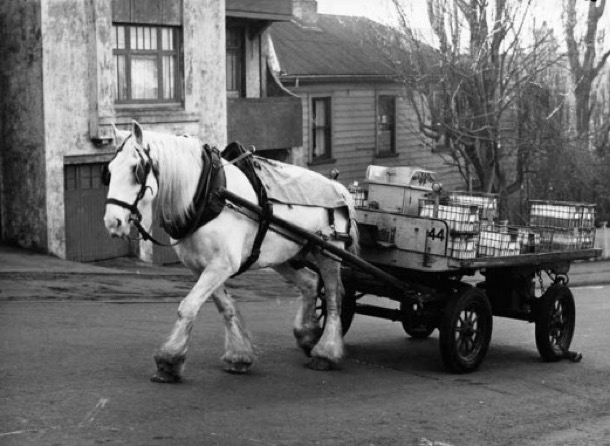
The baker trotted down the street carrying loaves in a big wicker basket slung on his arm. There were only two types of bread: ‘white’ and ‘brown’ (or what we’d call wholemeal these days). They were high-top loaves which could be broken into two halves. Some people only had half a loaf delivered each day and maybe a full one on Fridays for the weekend.”
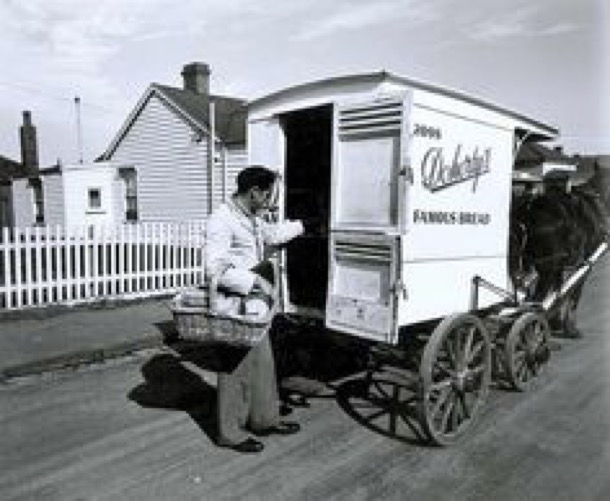
Our mother walked to the local grocer, fruit shop and butcher once a week where the rest of the food was bought.The shopping was delivered to our house until we bought a car. From then on the shopping was collected by our father on his way home. The butcher and greengrocer were much the same as today, except that the butcher had sawdust on the floor and there was not a piece of cling wrap plastic to be seen. The grocer however was very different.

No taking pre-packaged items off the shelves, instead the grocer served his customers putting all the items bought into very sustainable brown paper bags. Big tins lined some of the shelves that held such items as biscuits, broken biscuits and small items such as dried fruit and larger bins held flour sugar etc. The best thing about the grocer was the inexpensive treat of a small bag of broken biscuits. Soon after we moved to Box Hill South, the amazing Foodland Supermarket opened and gone were the days of personal service and bags of broken biscuits for children.

Sue, Margaret, Rikki and Fred
Susan:
The 1960s was rather a bleak period in my life. The break up of our parents’ marriage, and the aftermath, had a profound affect on many lives. For me, in the sixties, it robbed me of my adolescence, at time when one should be free to learn, gain confidence and independence and, something always close to my heart, have adventures. This unusual friendship between my sister Margaret, her boyfriend at the time Fred and another girl, Rikki, provided just that, for which I will be forever grateful.
Margaret:
Fred had been called up. He was 19. The marble with his June 5th birthday had been drawn out of the barrel. National servicemen were dying in Vietnam. Glamorous pop star Norma Rowe, whose name had been on my pencil case for a while, was the Nasho poster boy, but the black and white TV screens showed the horror of guerrilla jungle warfare, in the kind of detail that would change the coverage of war for ever. After Vietnam, governments learnt to control the footage and the access. But in Vietnam we saw it all.
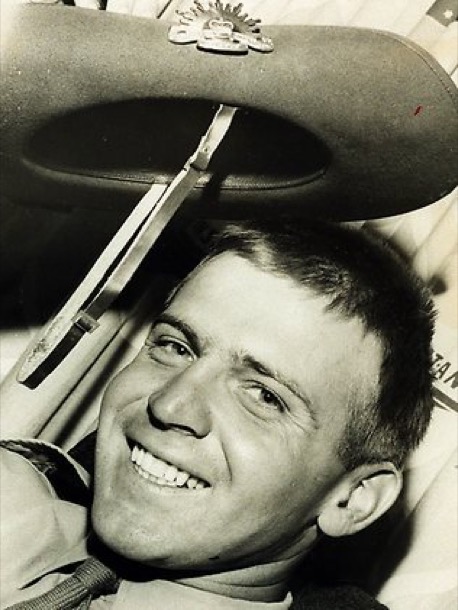
Normie Rowe, conscript.
The Seekers' “If you go away On this summer day Then you might as well Take the sun away….” had been all over the radio that summer. Sixteen and prone to drama, I wallowed in the emotion of my lovely boyfriend being sent to Vietnam.

Fred and Margaret 1967
Fred was sent an appointment for a medical. Luckily he failed the medical and was reprieved. Another family friend who was an offical conscientious objector had to face court, and many went to jail.
Susan:
A breath of fresh air from the outside world came rushing into my life bringing with it new books to read about sea otters in Far North Scotland and Moomins; movies; photography; Carlton; fairy toadstool rings under pine trees at the Basin and above all the magical world of the Australian High Country. Rikki had an interest in the romance of the High Country, as she loved Elyne Mitchell’s books, one of which is the classic The Silver Brumby, a favourite of children of our era. Other books written by Elyne Mitchell are also based in the High Country and tell of her early married life to Tom Mitchell who had grown up in the area.
They lived on his beautiful family property with a view of the Main Range. Here they pioneered the skiing in this area, getting to the tops by horse and pack horse and then walking up a steep ridge from Geehi carrying their skis. We too were captivated by this world.
Rikki corresponded regularly with Elyne Mitchell, who, as you can imagine, was a fascinating woman. Fred also had a connection to this area, as he had spent his childhood and adolescence near Corryong. I had been through the Snowy Mountains on a school trip and was intrigued by this new world. We were all hooked, and thus began the adventures in the mountains.
I will never forget the excitement and thrill of discovery of that first trip in Easter, 1968. We set off up the Hume on Thursday night in the car our father very kindly lent us. A little after midnight, as we drove between Tallangatta and Corryong, we were telling the current scary story of a man on the roof of the car with a severed head. It was especially scary when we stopped to have a sleep in a bus shelter by the side of the road, too tired to go on. At least we had the sense to stop, even if it was freezing, especially sleeping on a concrete floor.
We were so naive and badly equipped for our trip. We camped at Khancoban , all sleeping in the same tent, bizarre, but we only had one, and then drove up to Seaman’s Hut on the Kosciusko Road and walked across to Albina Hut.
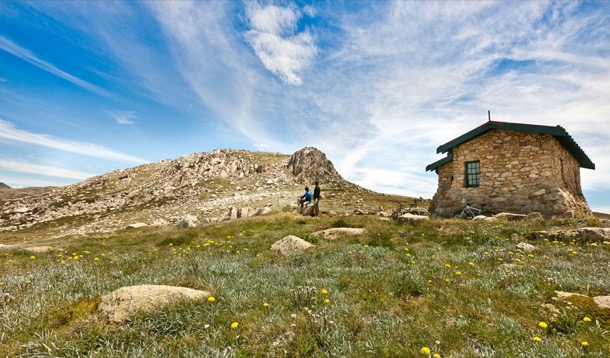
Seaman's hut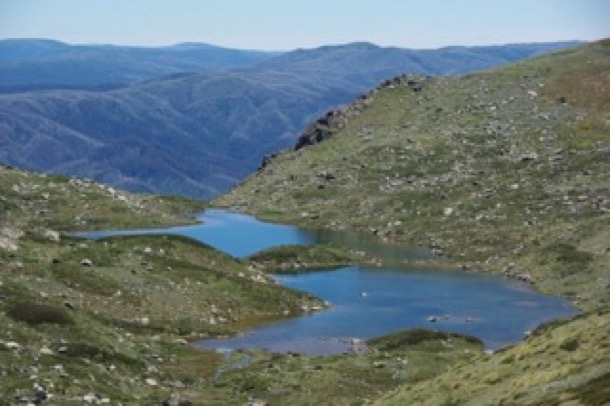
Lake Albina, viewed from Albina hut
Fred, in front of Albina hut, this time with a pack.
Albina Hut is in a beautiful glacial valley just below Mt Townsend, which is only nineteen metres lower than Kosciusko. Dangerous country to walk in with no tent, no proper mountain clothes and no previous experience. Fred even carried a suitcase and an umbrella!!!! What a sight we must have been to the seasoned mountain walkers who were also staying in this hut that belonged to the Geehi Ski Club. I don’t remember anyone commenting or even warning us about the rapid weather changes.
It was fabulous. Loved every minute of the walk: the snow grass, the flowers the stunning granite tors and luckily the cobalt blue sky. My love affair with grasses began here, as did my joy of walking in the mountains.

Sue and Fred in the Snowy Mountains
Margaret:
Around that time Rikki, Sue and I moved in together to the flat at the back of our parents’ house. We ate with the rest of the family, but it was a taste of independence. Sue was studying Art teaching in the city, Rikki was working full time, Fred was in his final year of Photography at RMIT and I was in my final year of school. Somehow through that year, in between weekends away and nights at the movies or out to dinner, I managed to snatch enough study time, but only just. I squirrelled myself away in Mum’s bedroom for the last couple of weeks before the exams.
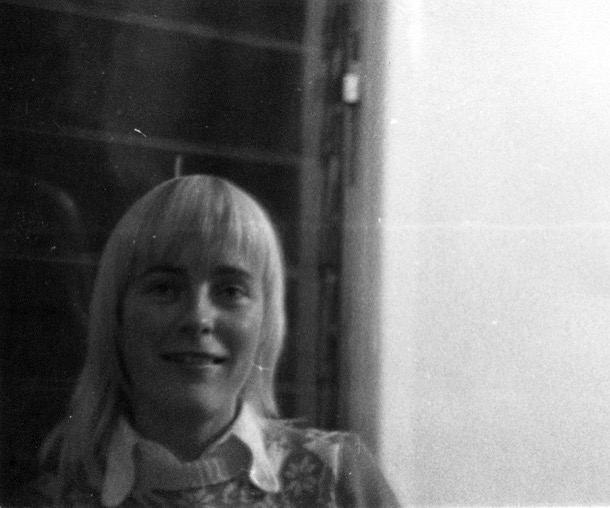
Rikki, 1968
That summer, after Christmas, we travelled up the Hume again, this time in Rikki’s little Volkswagen, “Greymouse”. Fred had spent his childhood living in Walwa, just over the NSW border, where his parents both worked at the Butter Factory. Family friends owned a farm that backed onto the Murray River near Corryong. Fred had spent childhood holidays exploring the river and knew of an island, reachable by car for most of the way, through the farm tracks. We lugged all our camping gear through the bush, waded over the river and set up on the island. I remember heat and flies, but also ants. We had a bush table on which the camp stove sat. Cooking required a tarp, on the ground in front of the table, wetted with river water, to keep the tiny ants from swarming up one’s legs.
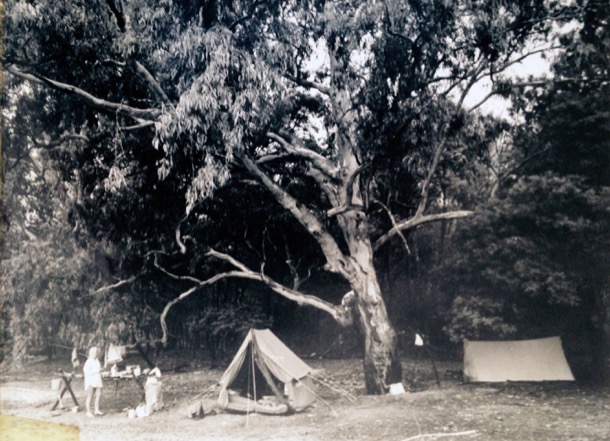
Camp on the island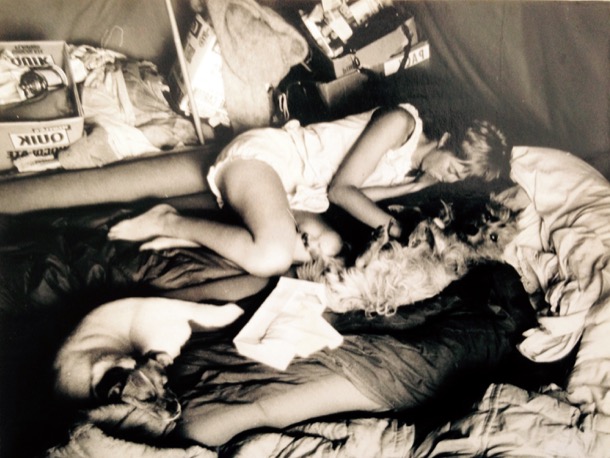
Inside the tent
Most of the time we were blissfully alone. However I remember lying naked in the river, hearing voices in the distance and being invaded by a scout troop on a canoeing expedition. I remember my acute embarrassment, lying in the all too shallow river. There was pointing and laughter from the scouts and unsympathetic mirth from my companions.
One night we drove to Corryong to have dinner. Afterwards, in the dark, perhaps a little drunk, we found out way back along the farm tracks, hiked through the bush and waded across the river back to our camp. We had torches, but in those pre LED days, torches were dim affairs which barely gave any light.
My exam results came out during that week and a simultaneous announcement of tertiary placements. This involved buying the Age newspaper and looking up your name. Once again we made the trek out to the car and drove to town. I was full of trepidation. How could such a distracted year and so little work end up with a place at Monash? Somehow it did. I was offered place in Monash Arts and a studentship.
Sue:
Our last trip together to the mountains was a year later, in January 1970. A very different experience but we followed our established pattern of the now many trips up here. We were on our way from Corryong to Khancoban all packed together in Rikki’s grey Beetle. In this small car we managed to pack four adults, two dogs, camping supplies and food. Unbelievable! It was very hot and the grass was straw coloured against a blue, blue sky when around the bend on the wrong side of the road came a car, driven by a worker from Snowy Hydro: a head-on in a rear-engined Volkswagen. We were very lucky.
Unhurt except for bumps on the head and a substantial coating of flour from an open packet in the food box we stumbled out of the car which was undrivable but only slightly damaged.
We did not get to the mountains, but we did get to stay with Elyne Mitchell at Towong Hill for two days, dogs and all. Mrs Mitchell happened to be driving past, saw the accident scene and took us in. With all our goods and chattels now in Mrs Mitchell’s Landcruiser, we drove back towards Corryong, but this time took the turn off to ‘Towong Hill’. We had so often passed the turn off, wondering about the house, hidden by large trees at the end of the small dirt road.
It was a marvellous experience, staying in that big old house, a large two story brick house, built in 1904, even though Mrs Mitchell was a slightly forbidding and austere presence.
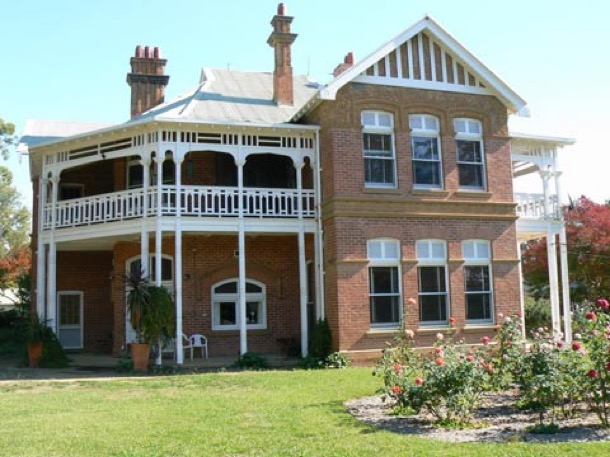
Towong Hill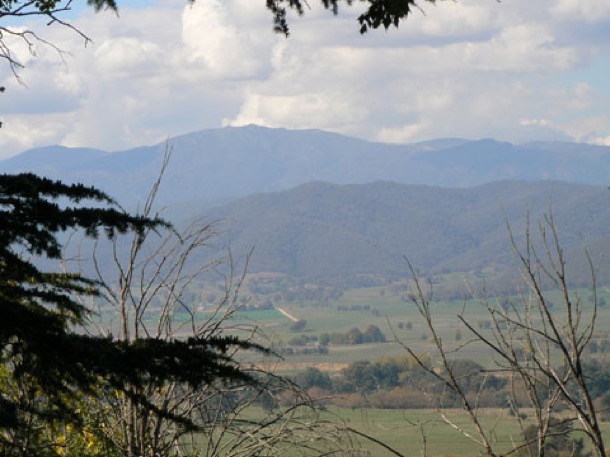
View from the house
We stayed upstairs in four of the many bedrooms. I remember white sheets and dark furniture and curtains blowing in the breeze. It was dark and cool downstairs, when we came down to breakfast the next morning. All the meals were served in the large formal dining room adjacent to a huge country kitchen. I remember Mrs Mitchell had biscuits, fresh tomatoes and herbs for lunch. No wonder she cut such a lean athletic figure.
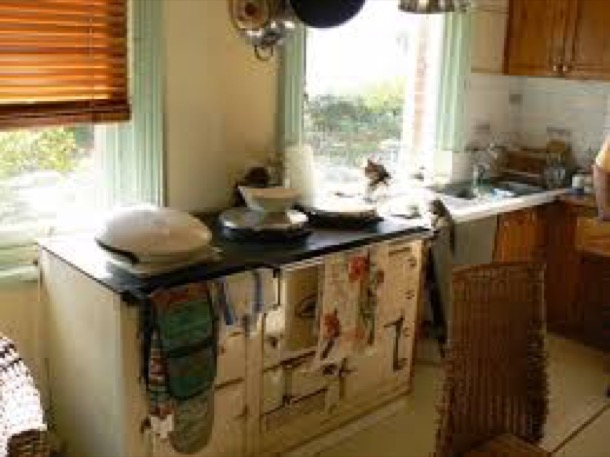
Towing Hill's kitchen
After we had been introduced to the many lovely farm dogs and seen the horses and stables, Mrs Mitchell suggested that a swim might be beneficial for our aches and pains. We drove down the hill to the river flats and the Mitchell's favourite swimming hole in a billabong of the Murray River. Bliss! It was still quite hot.
A last dinner in this world away and then the long drive back to reality. Fred’s brother Phillip was picking us up in the morning.
We did not realise at the time that we would not go to Albina Hut together again. Somehow that accident fractured the foursome but the friendships formed were to continue in a different forms for each of us.
